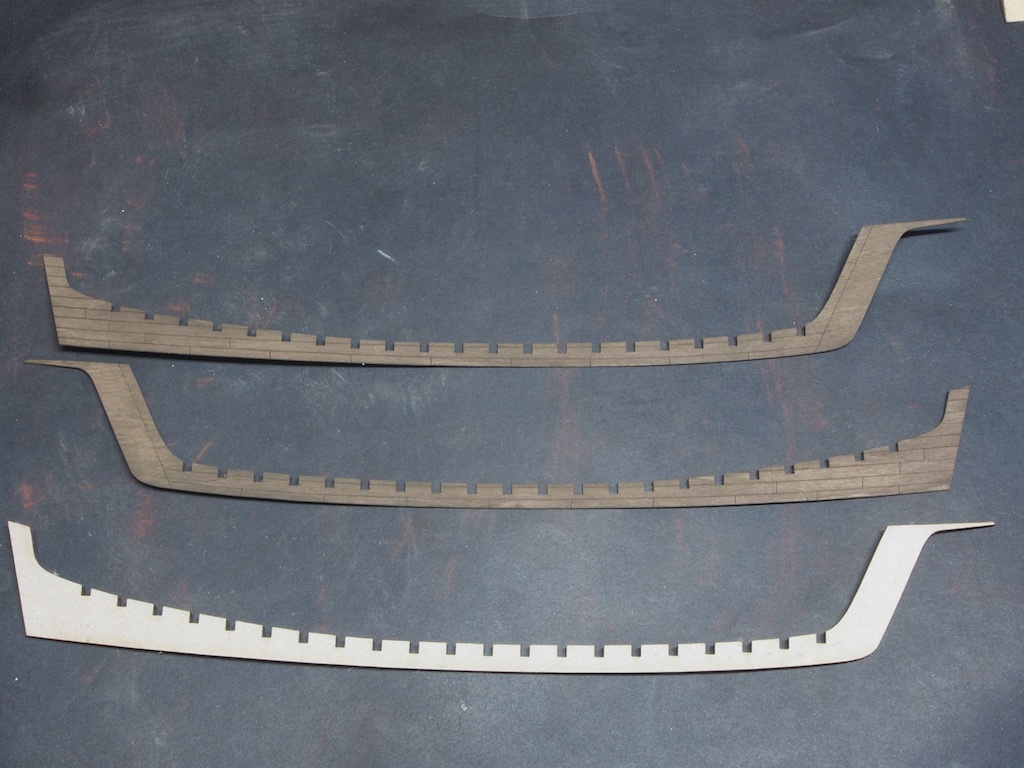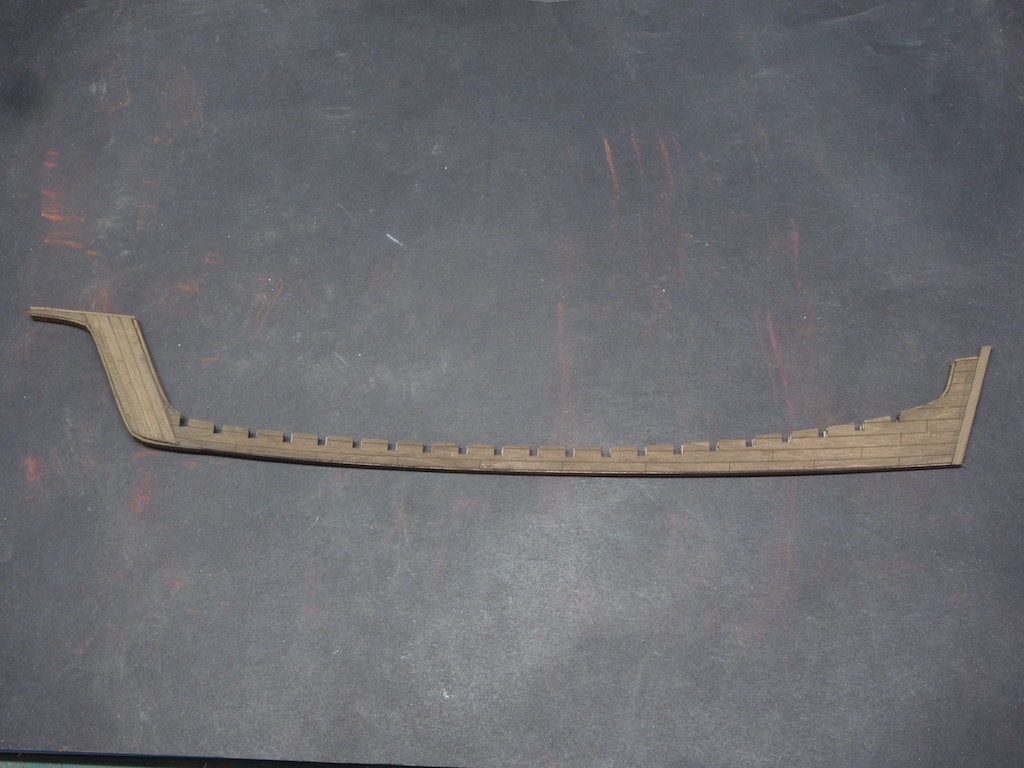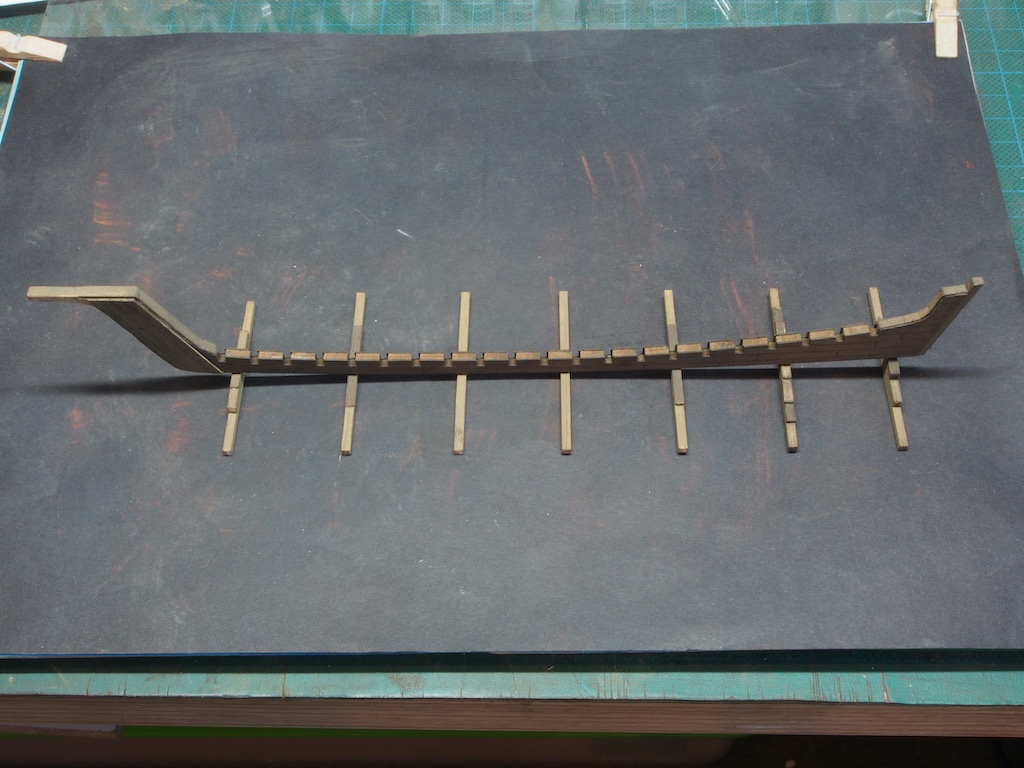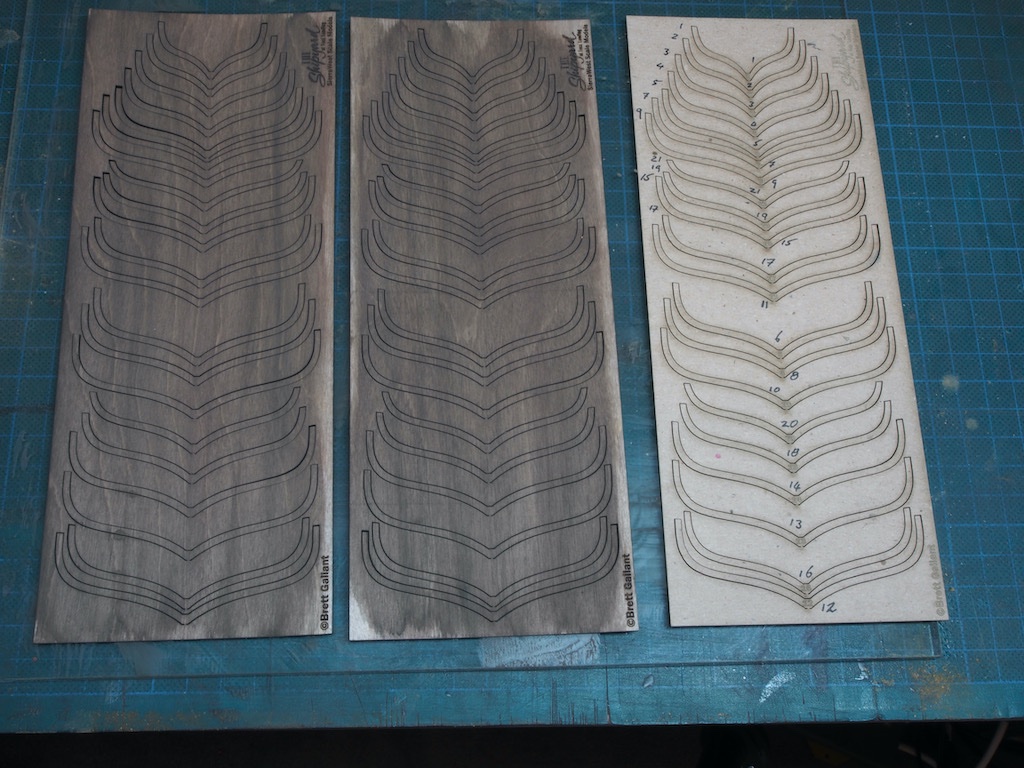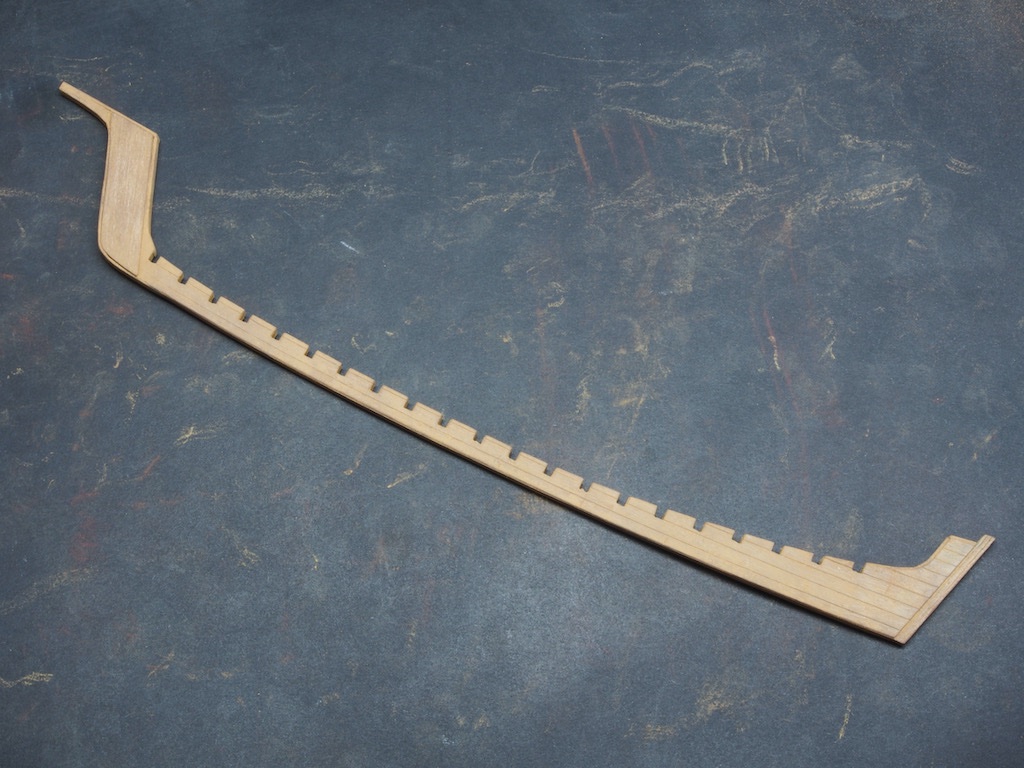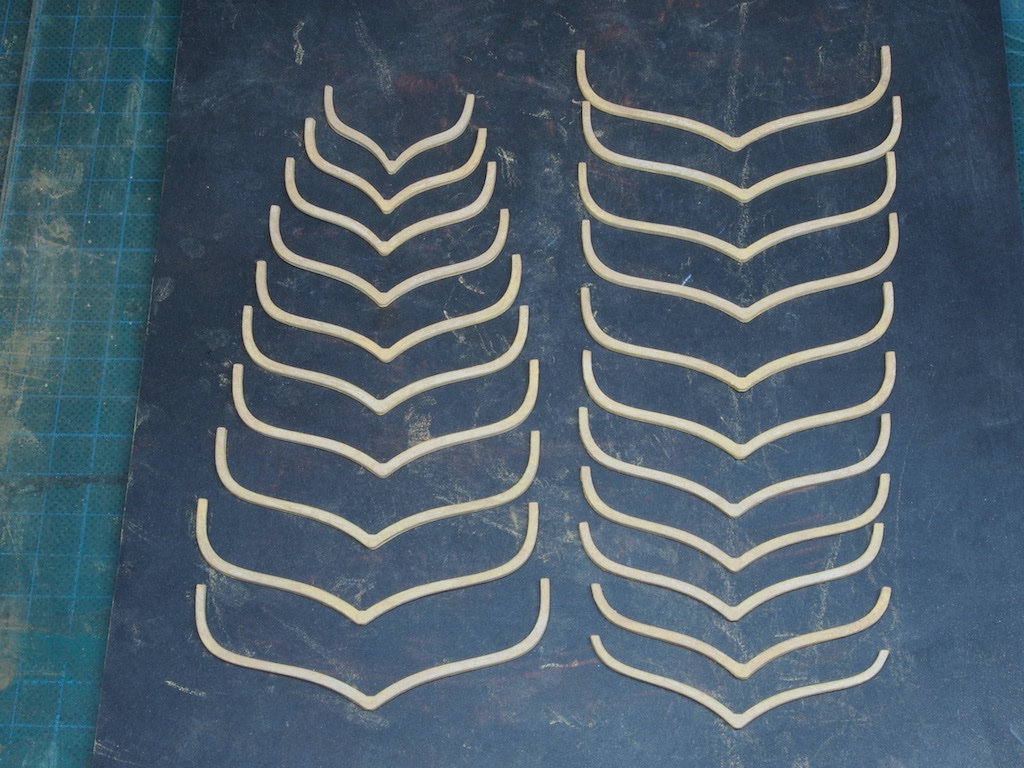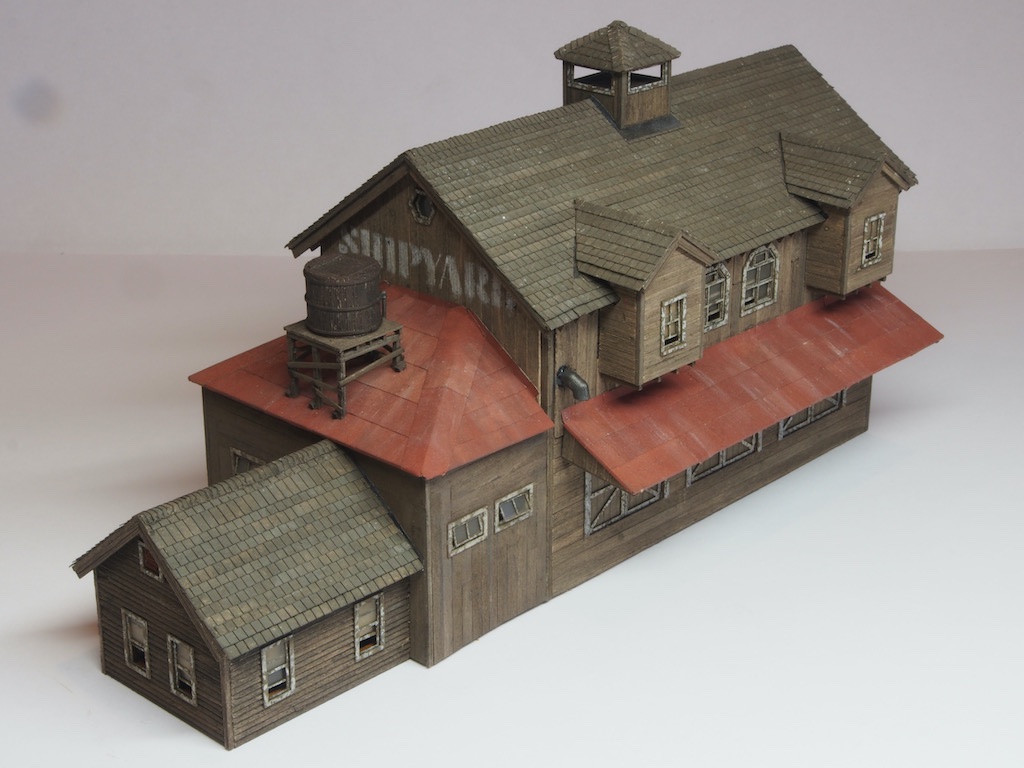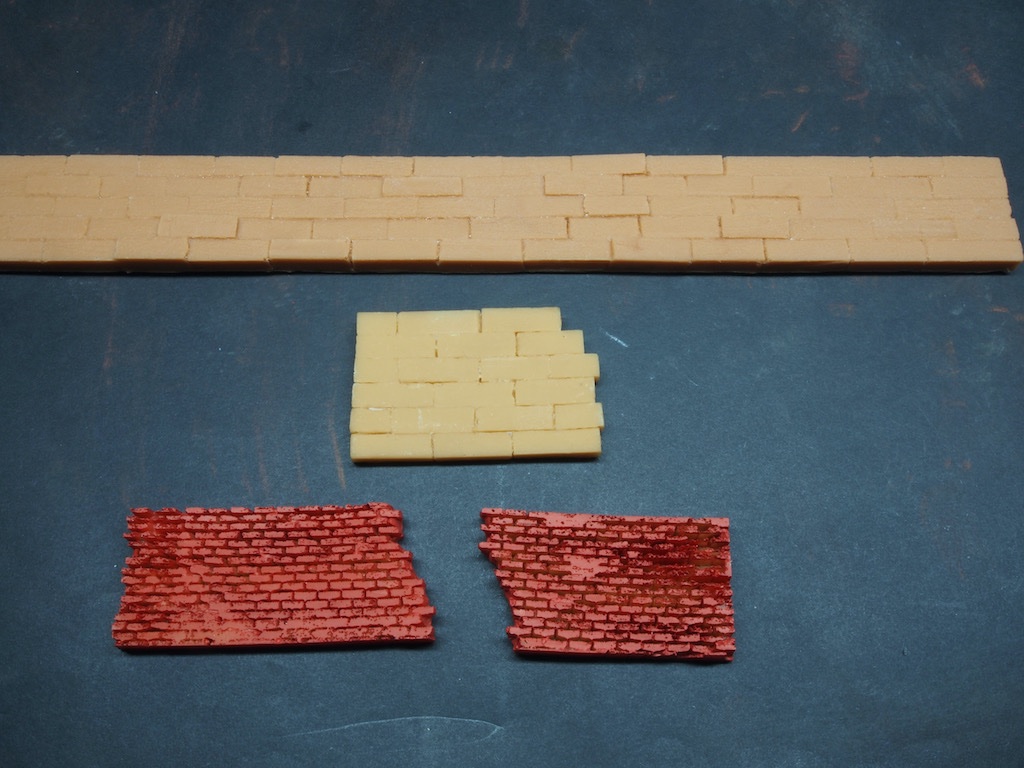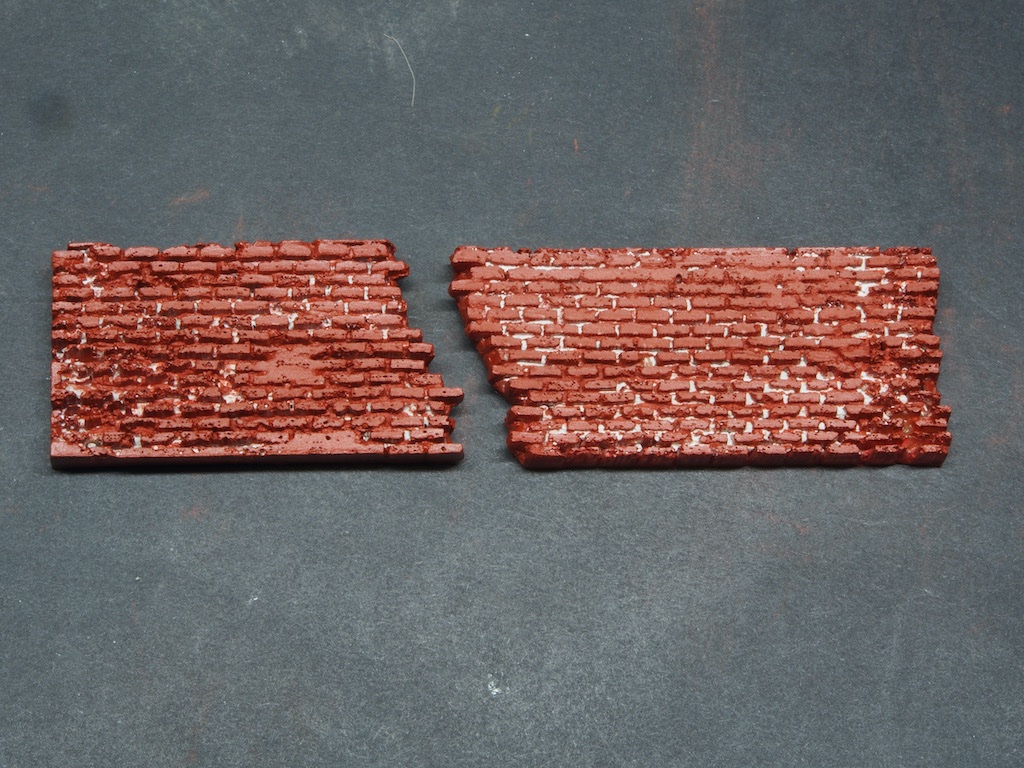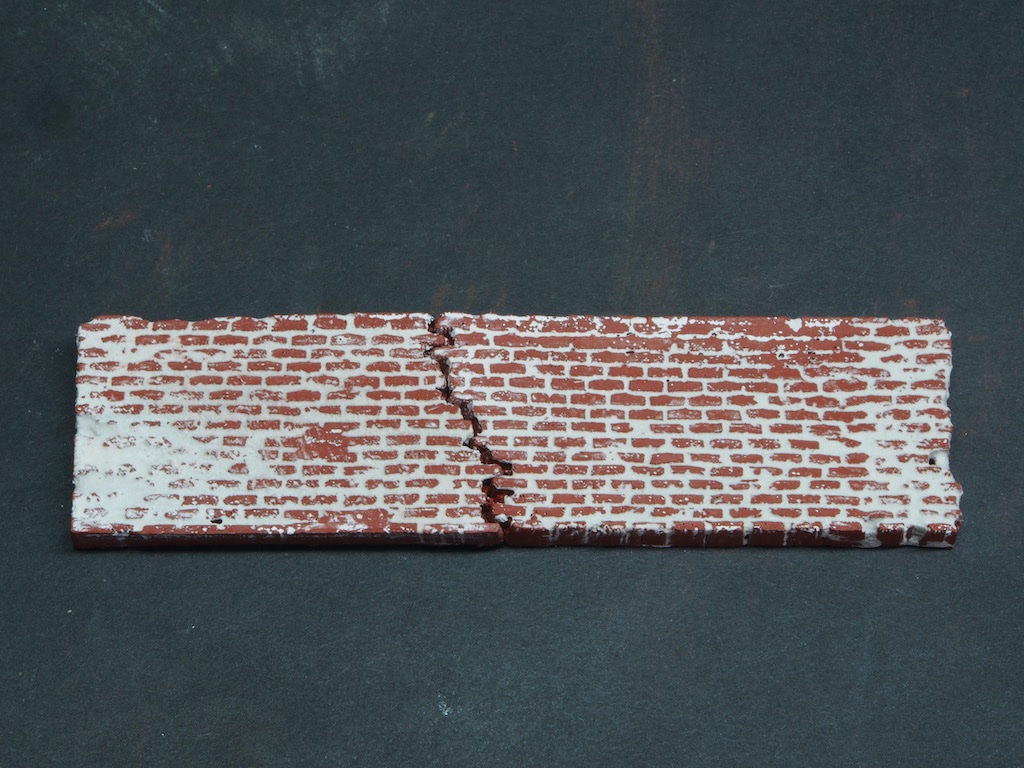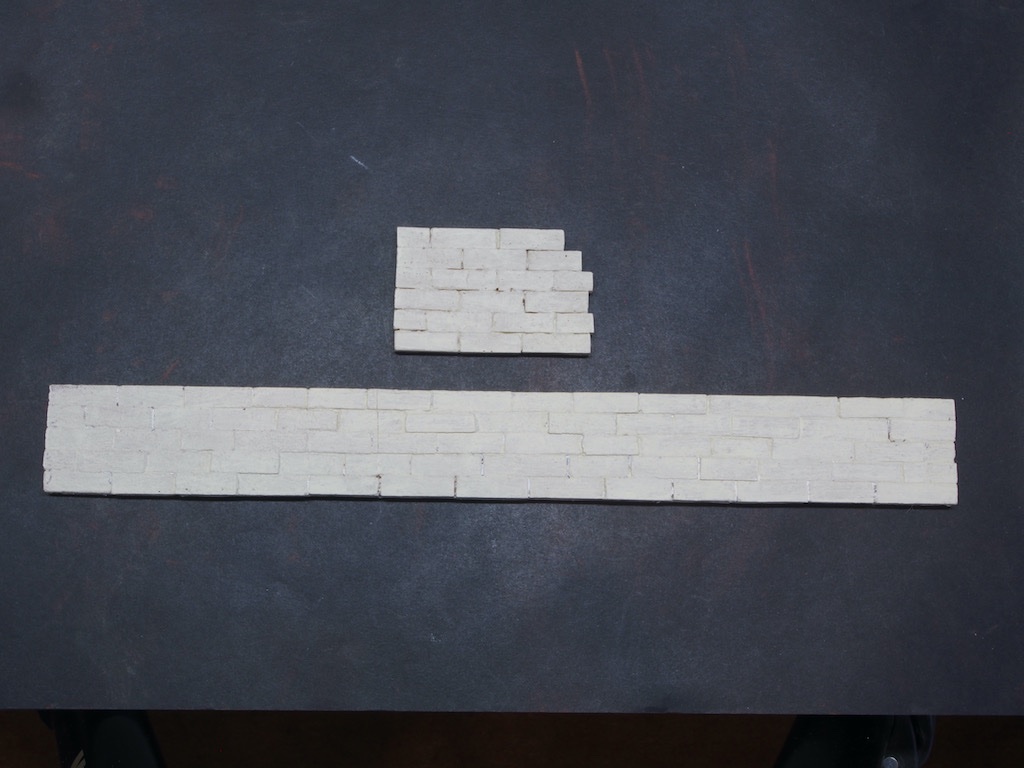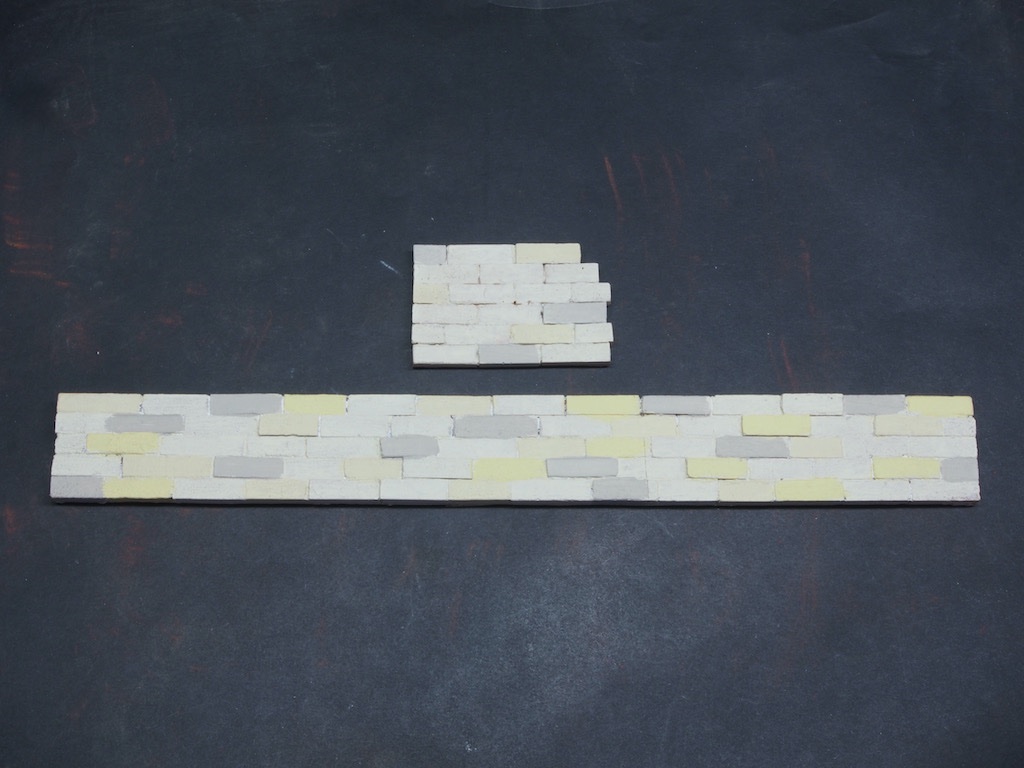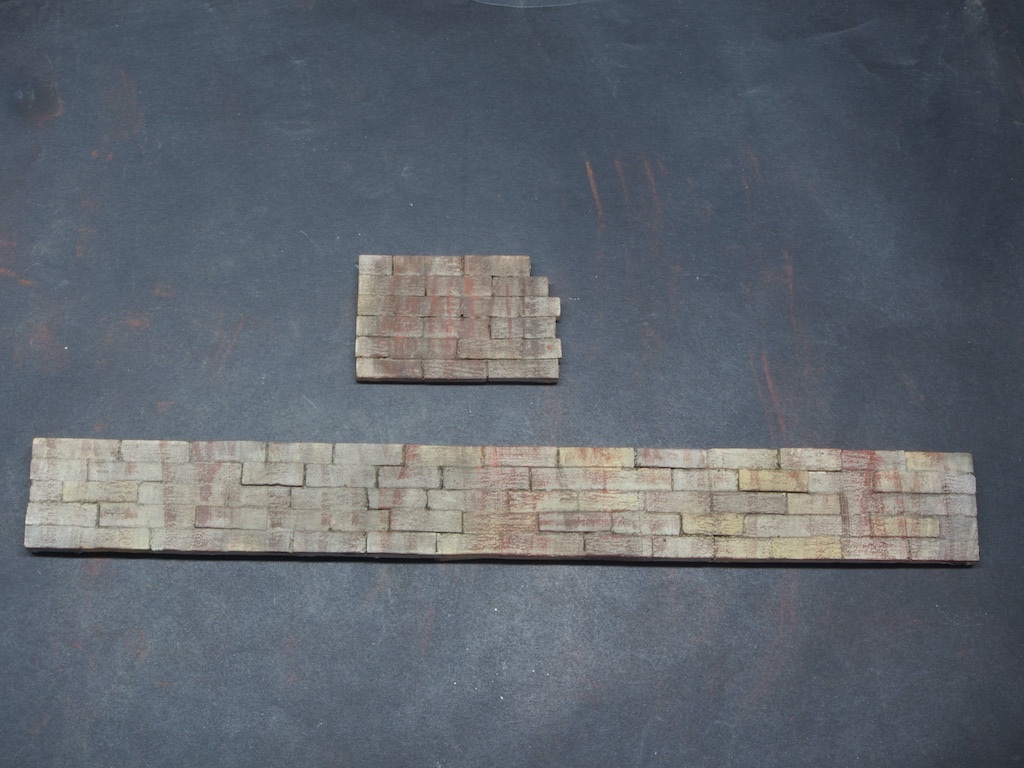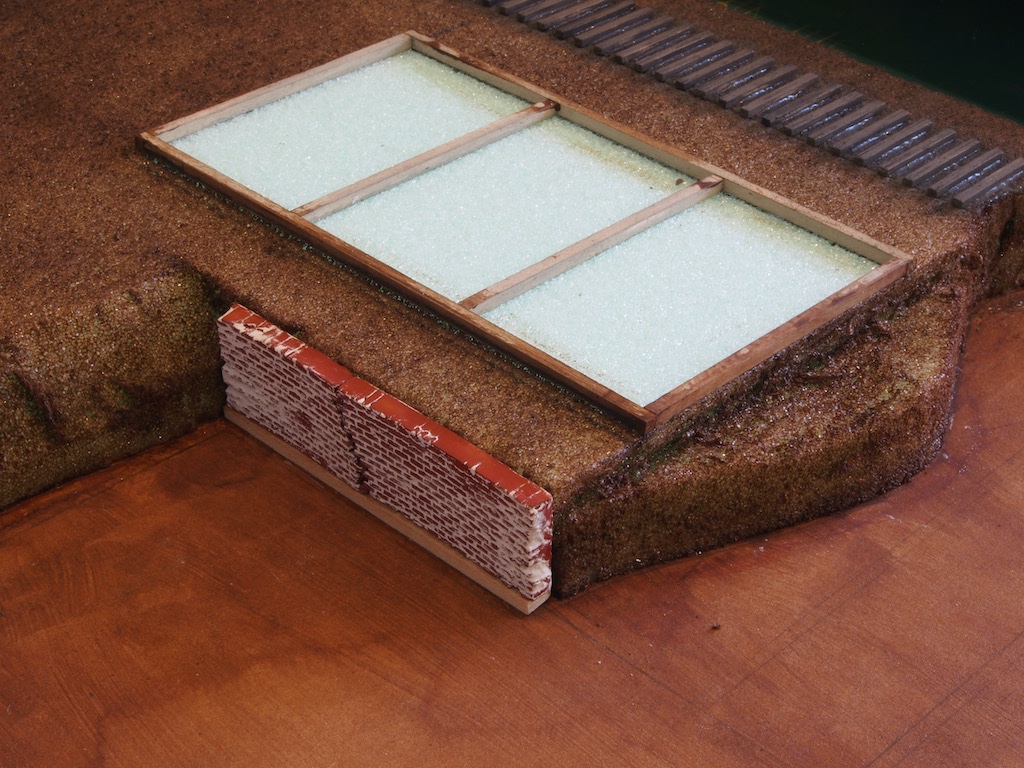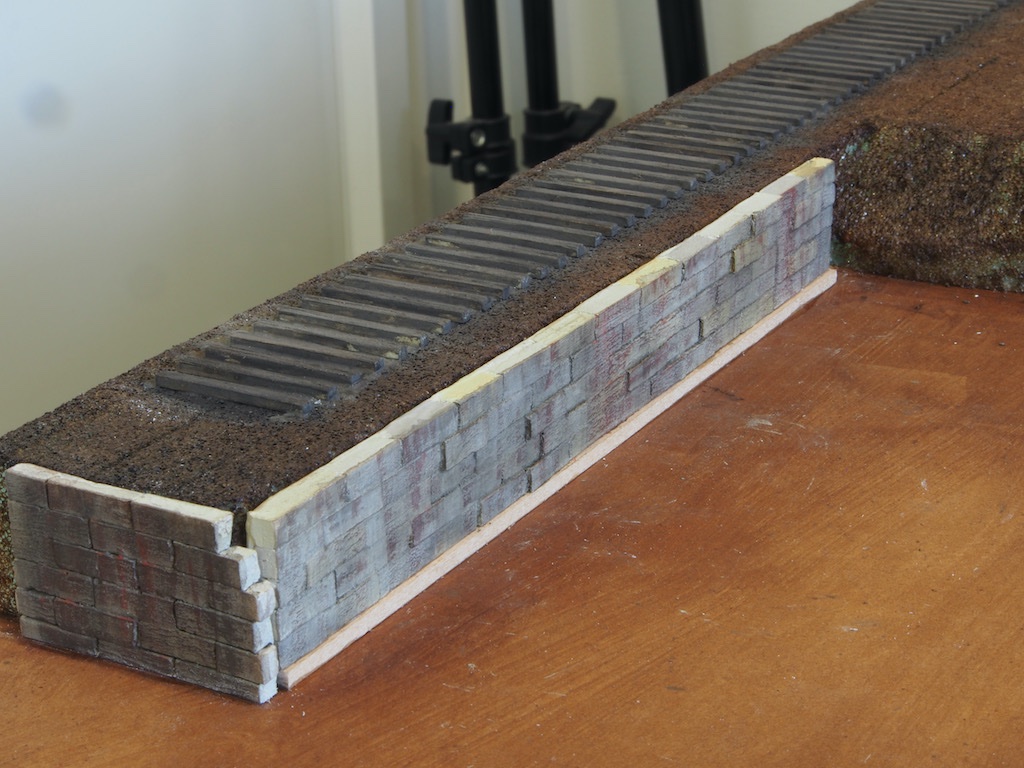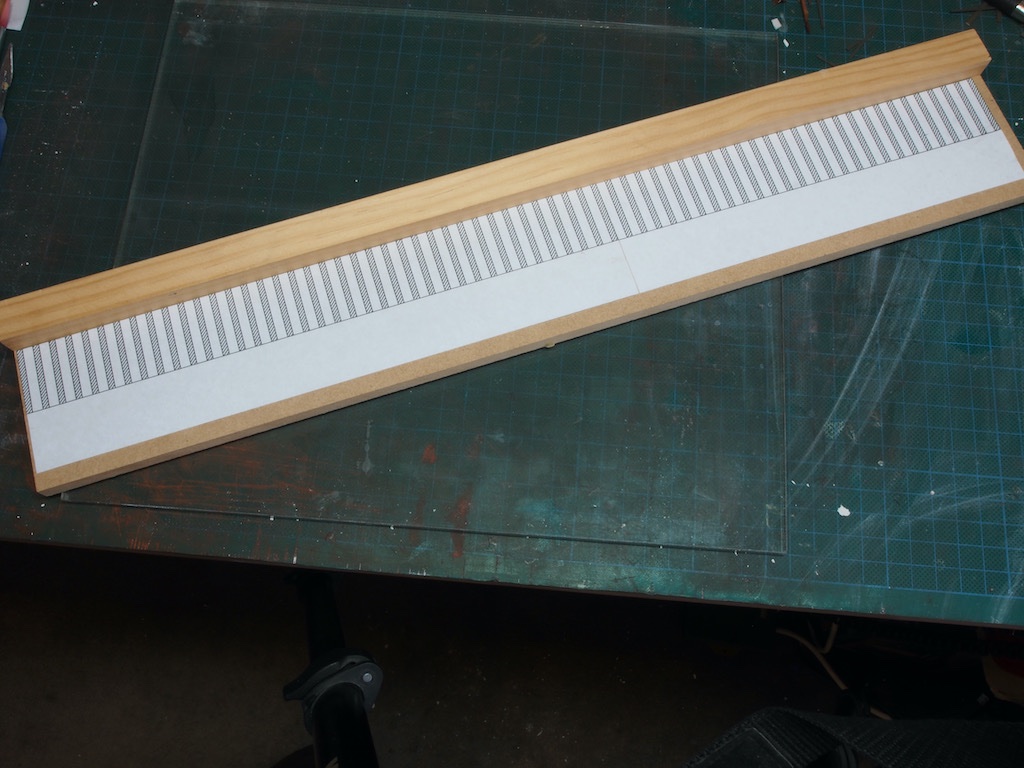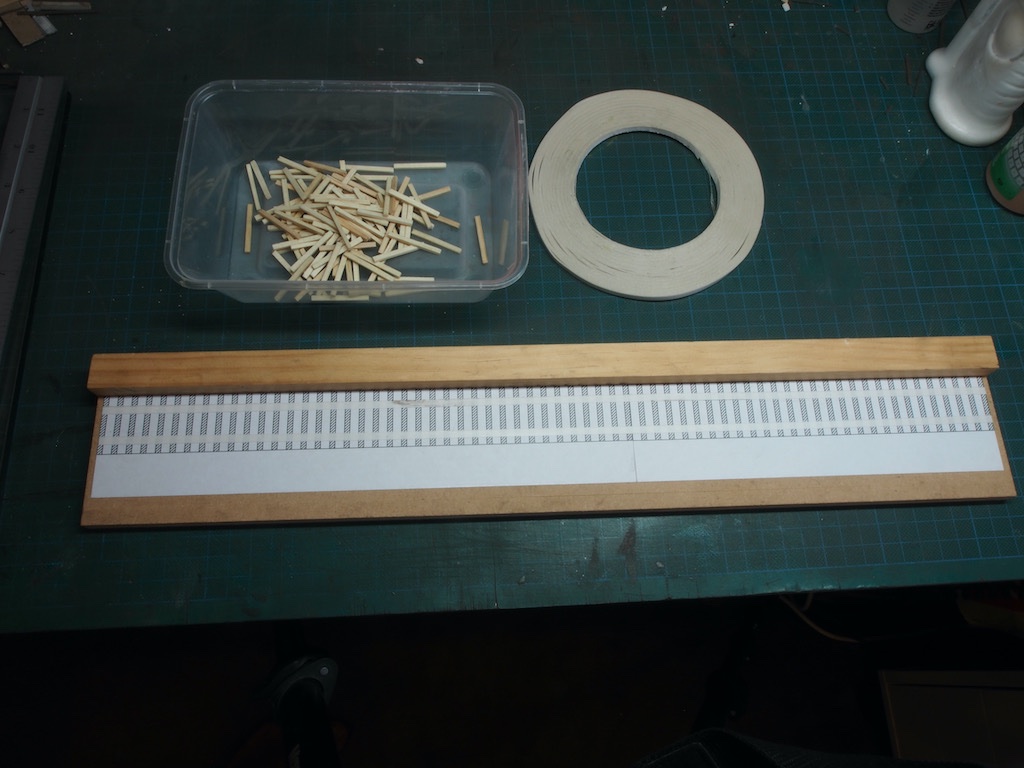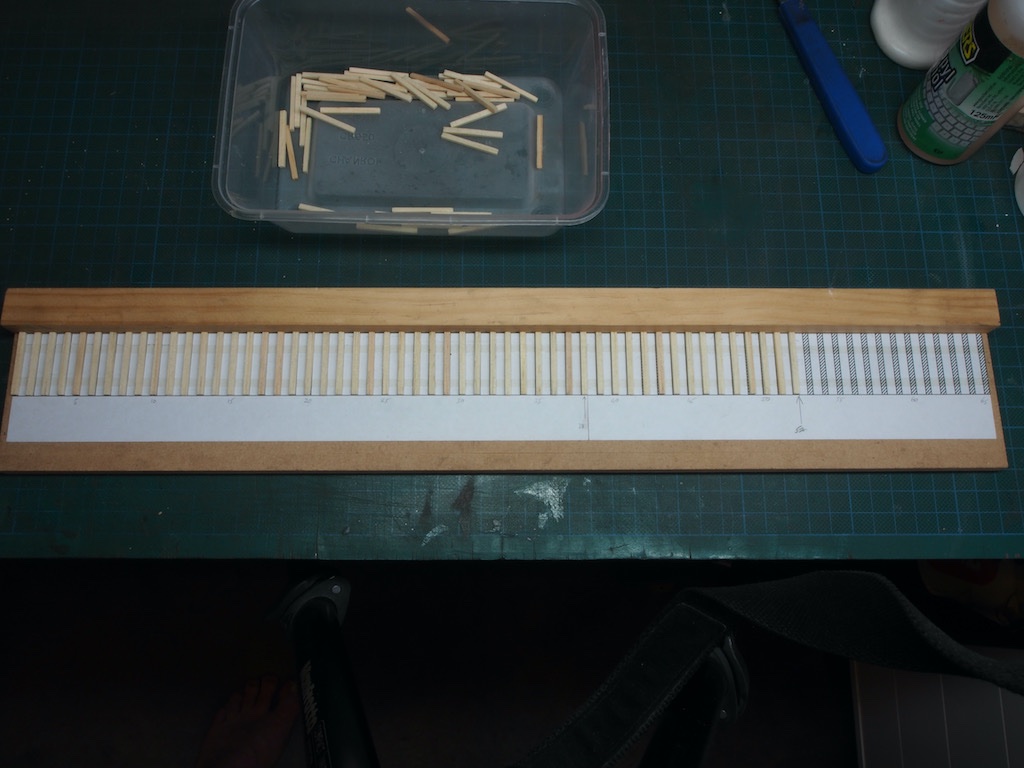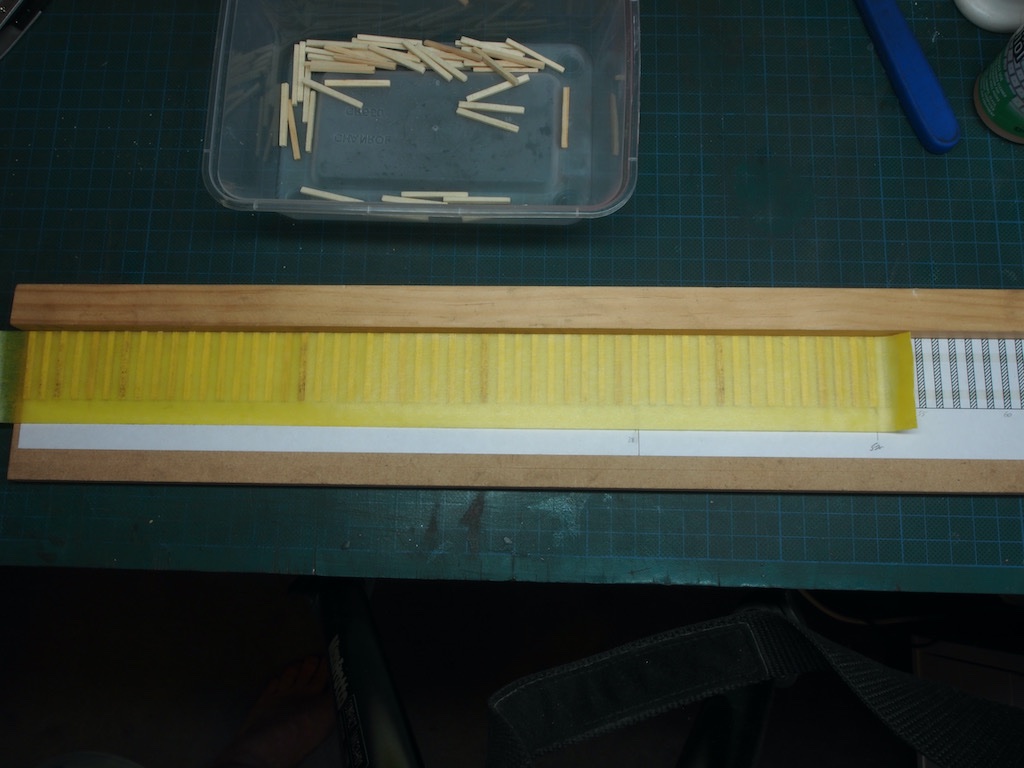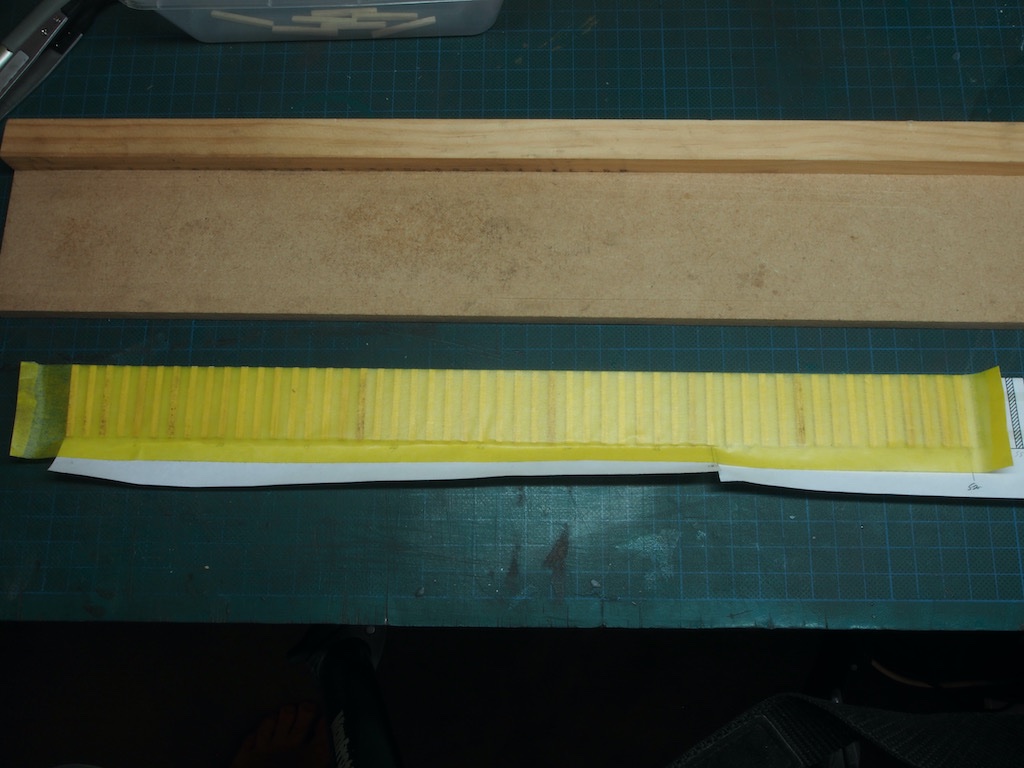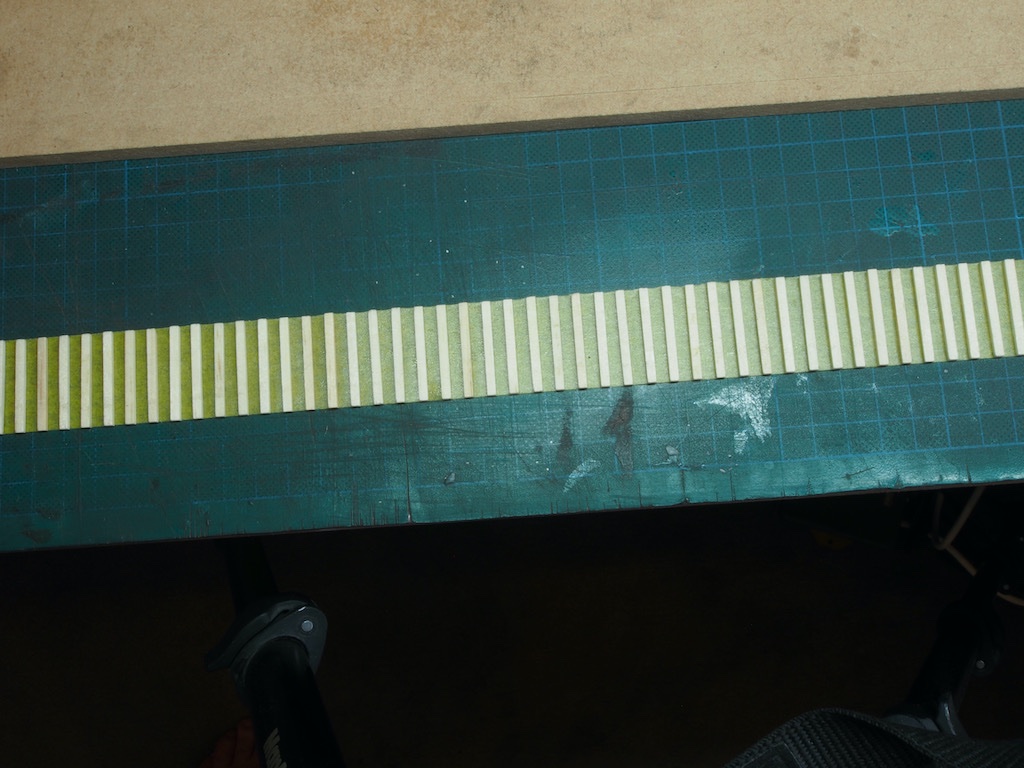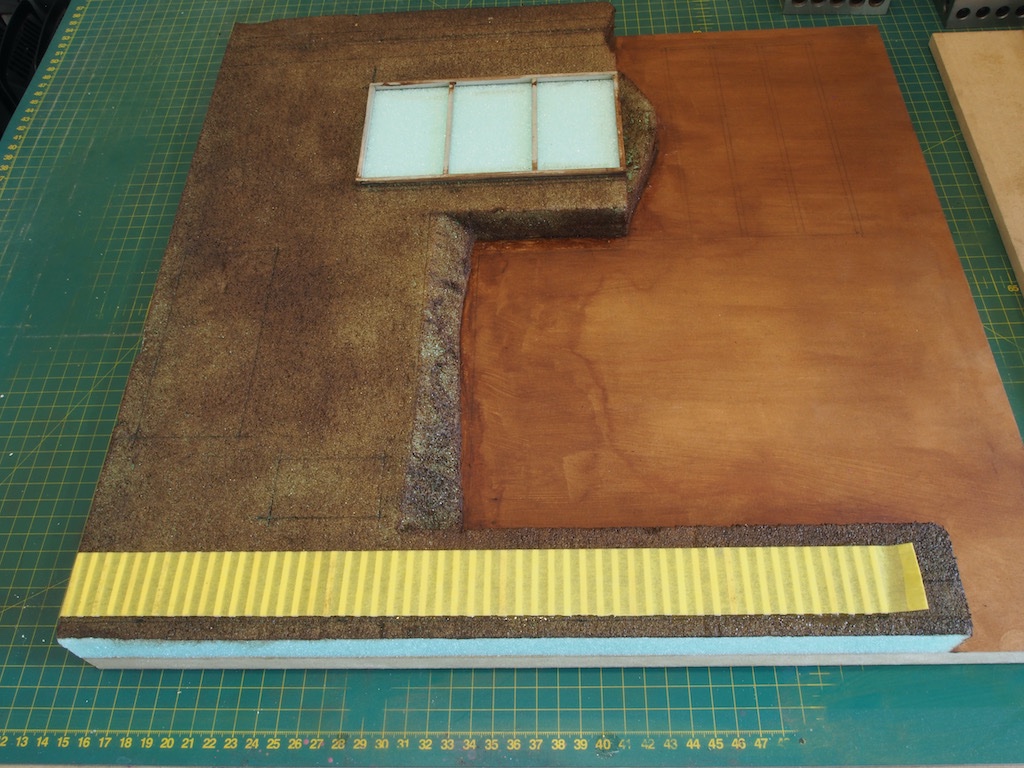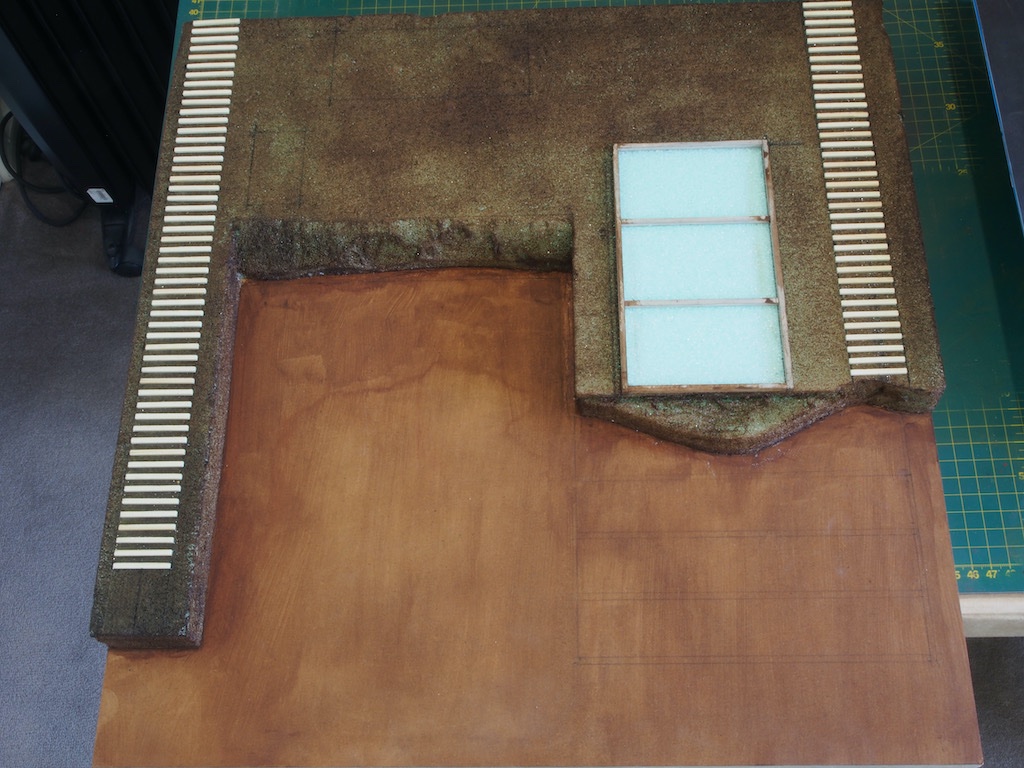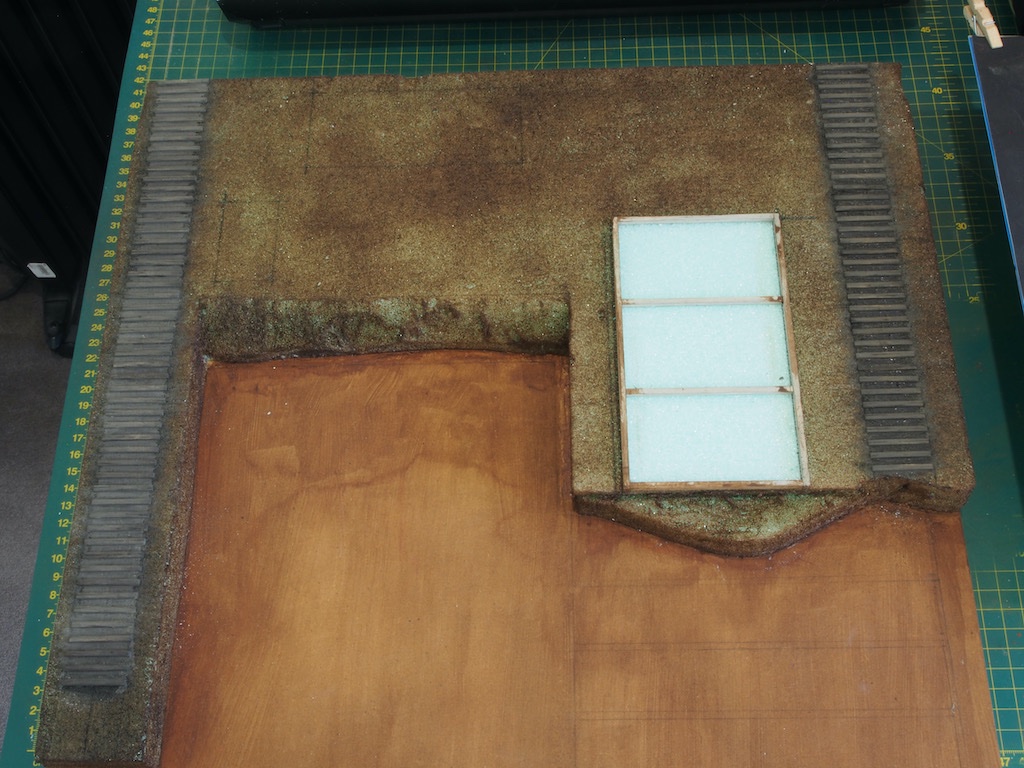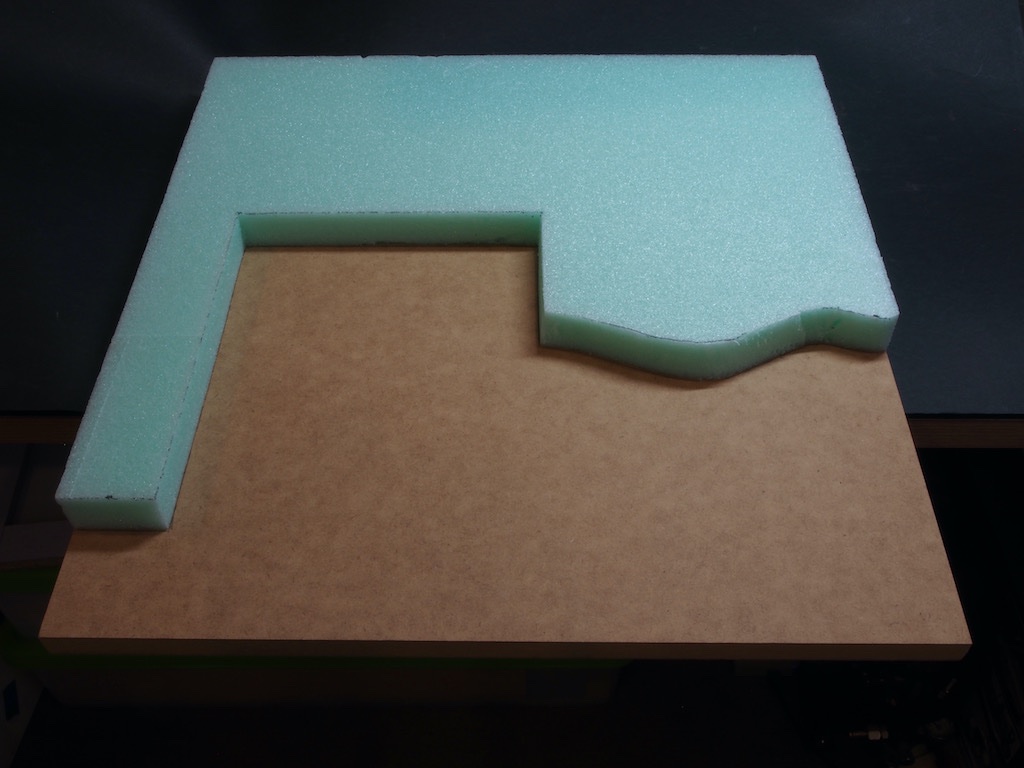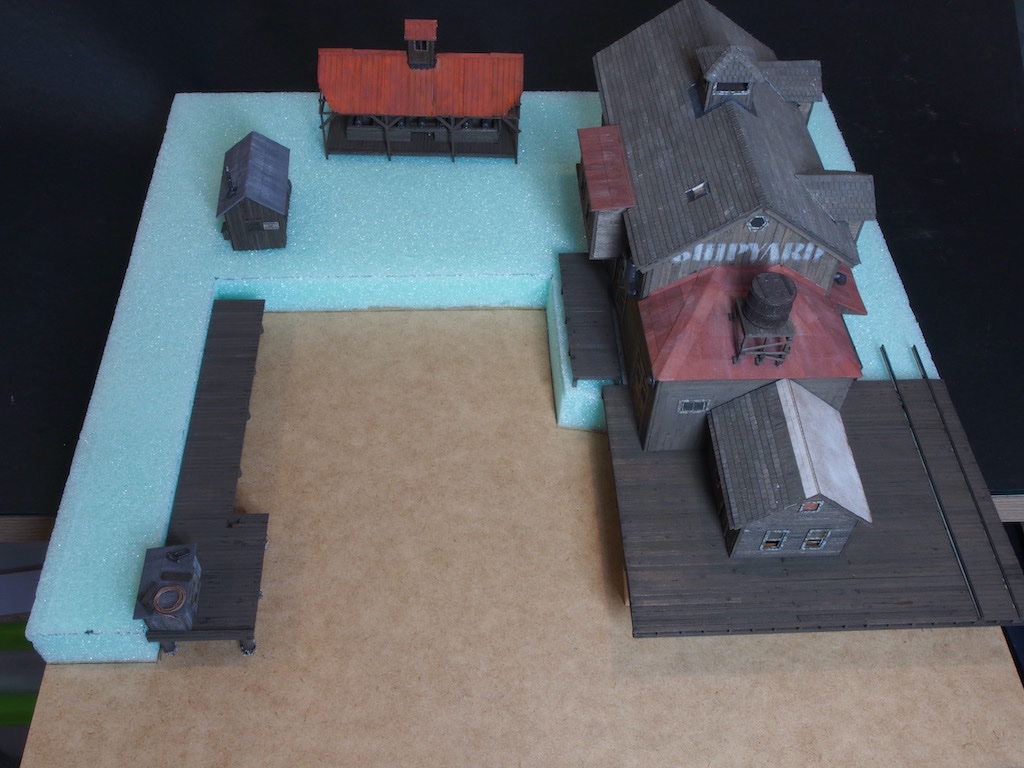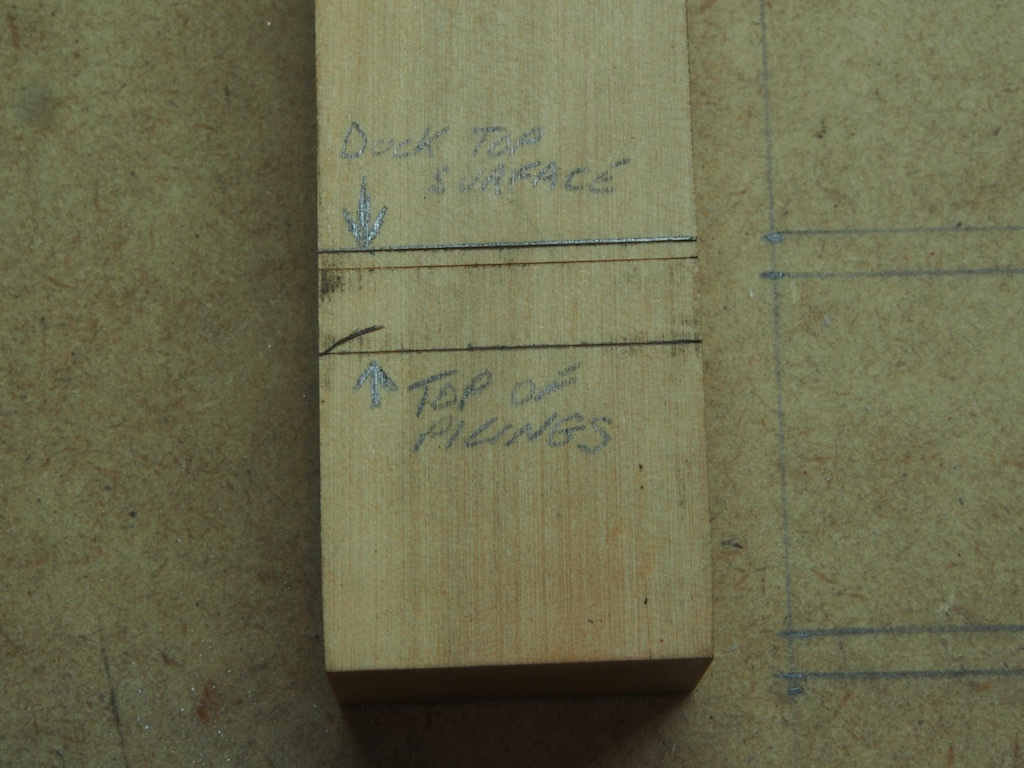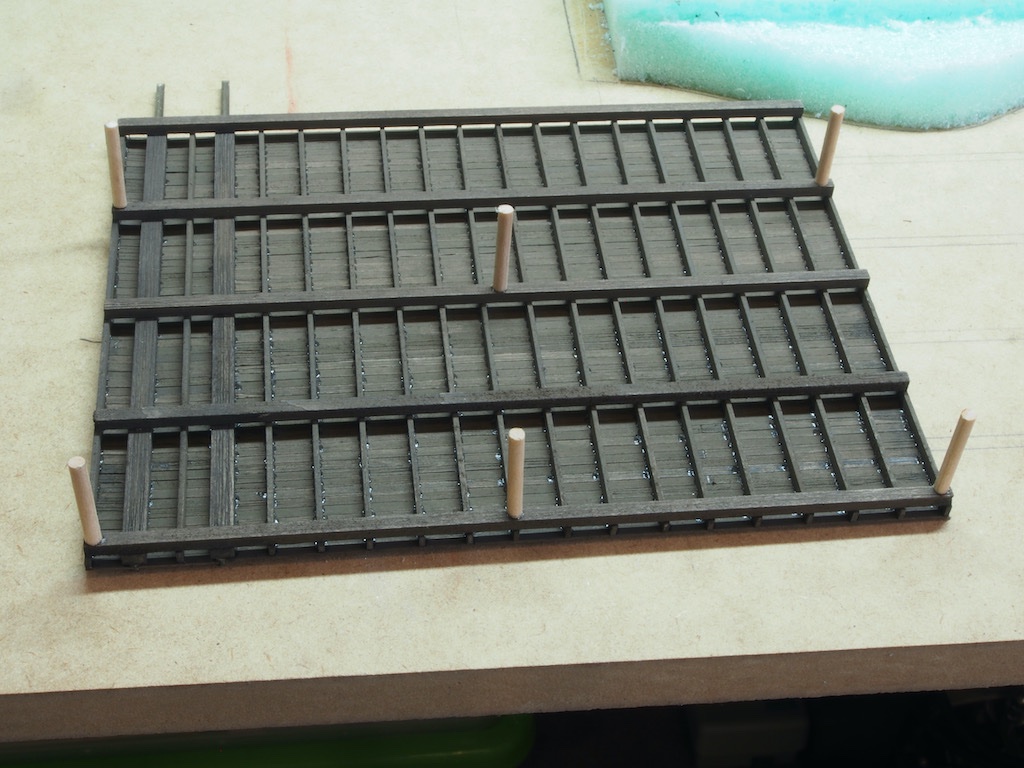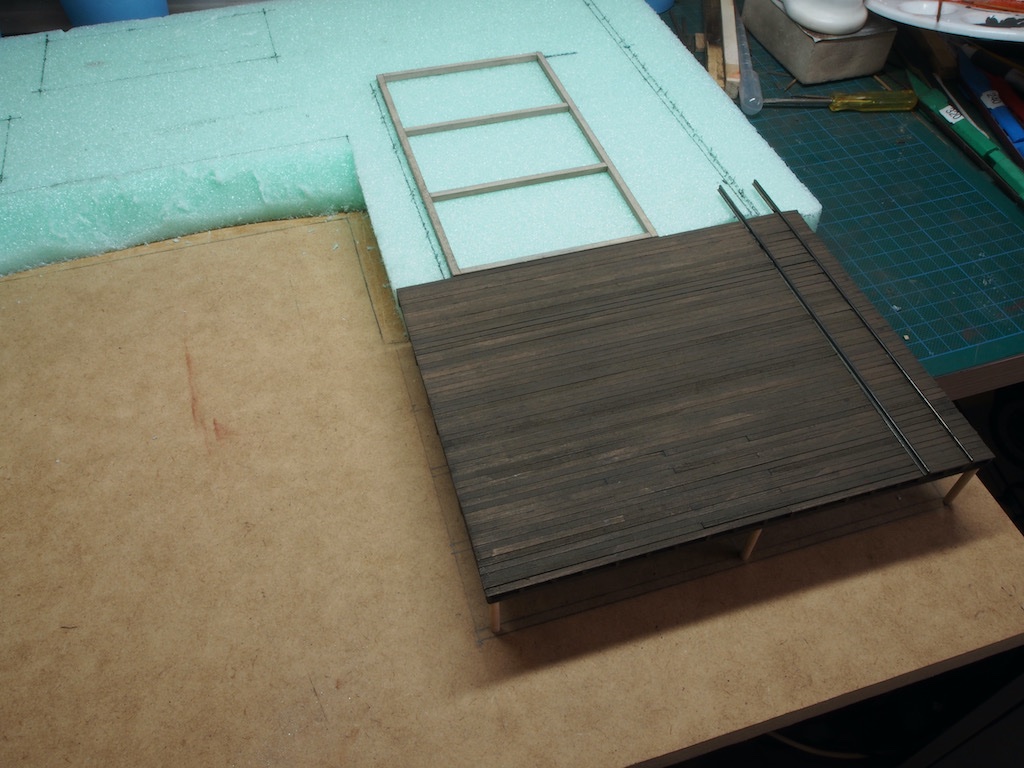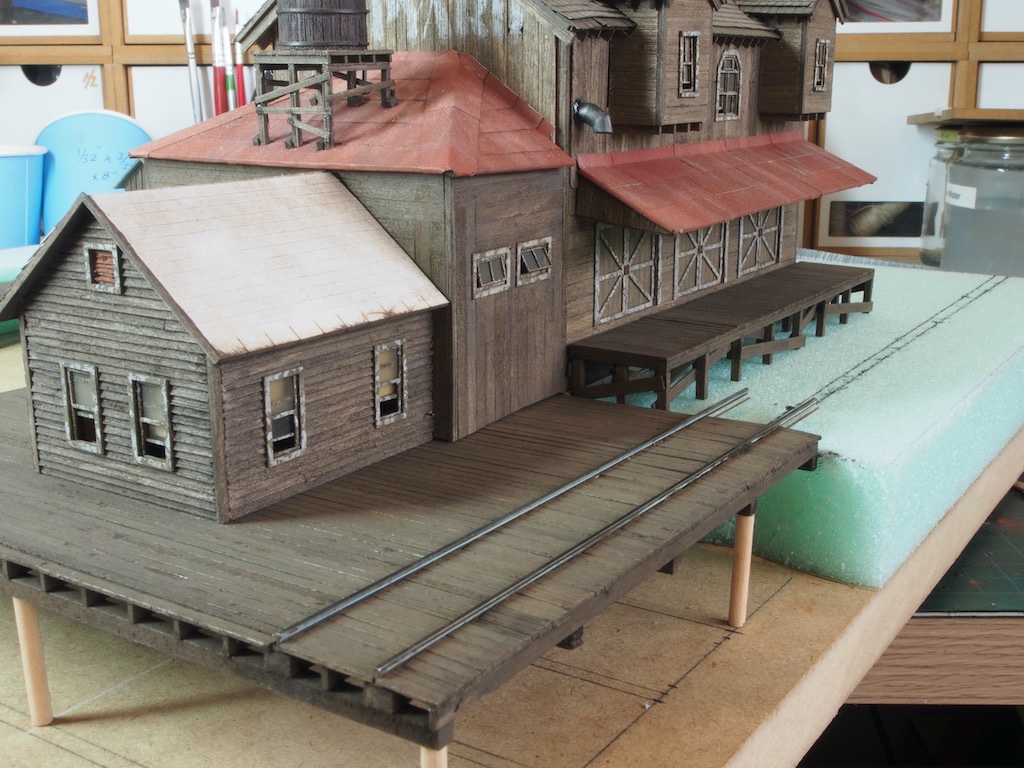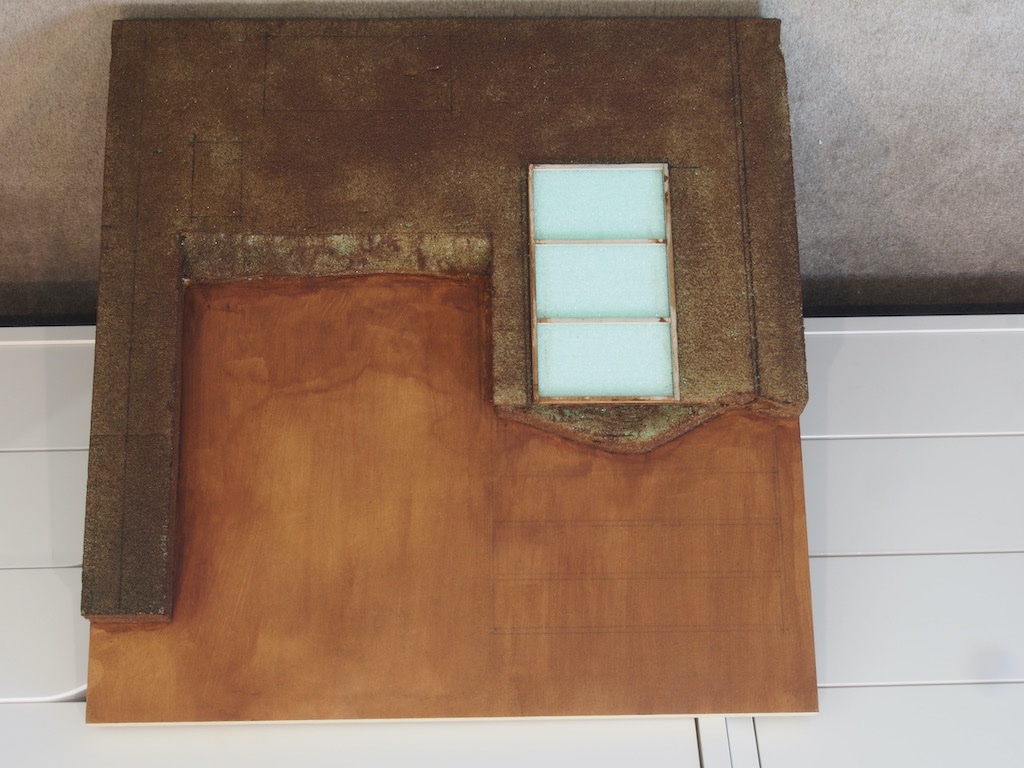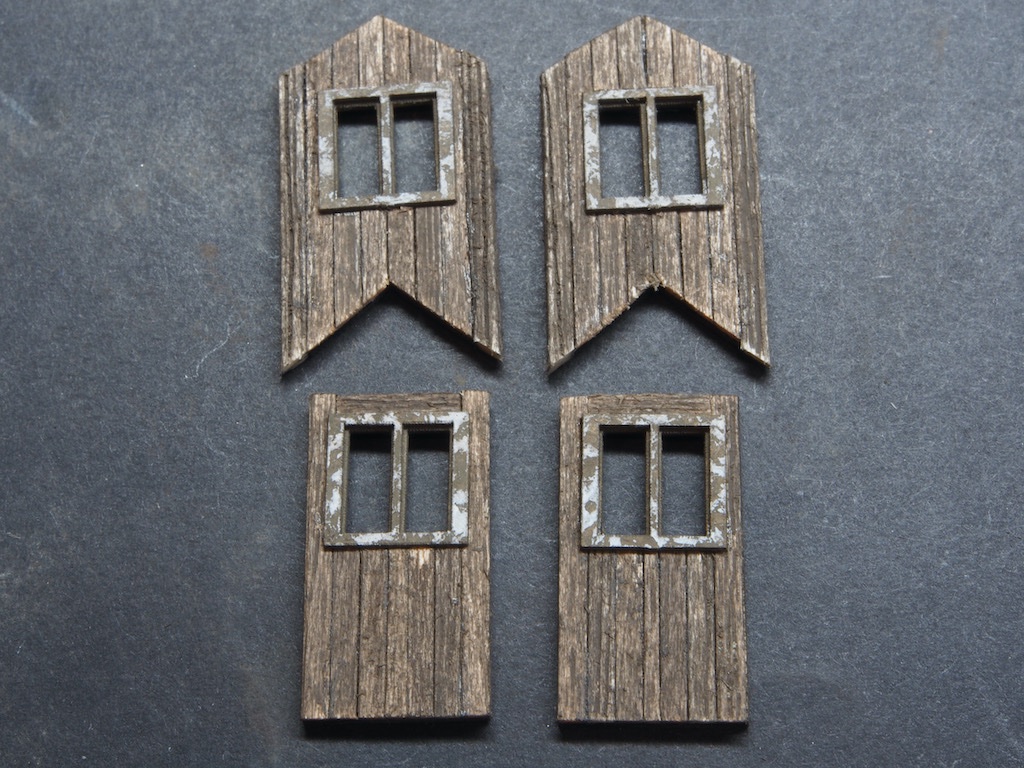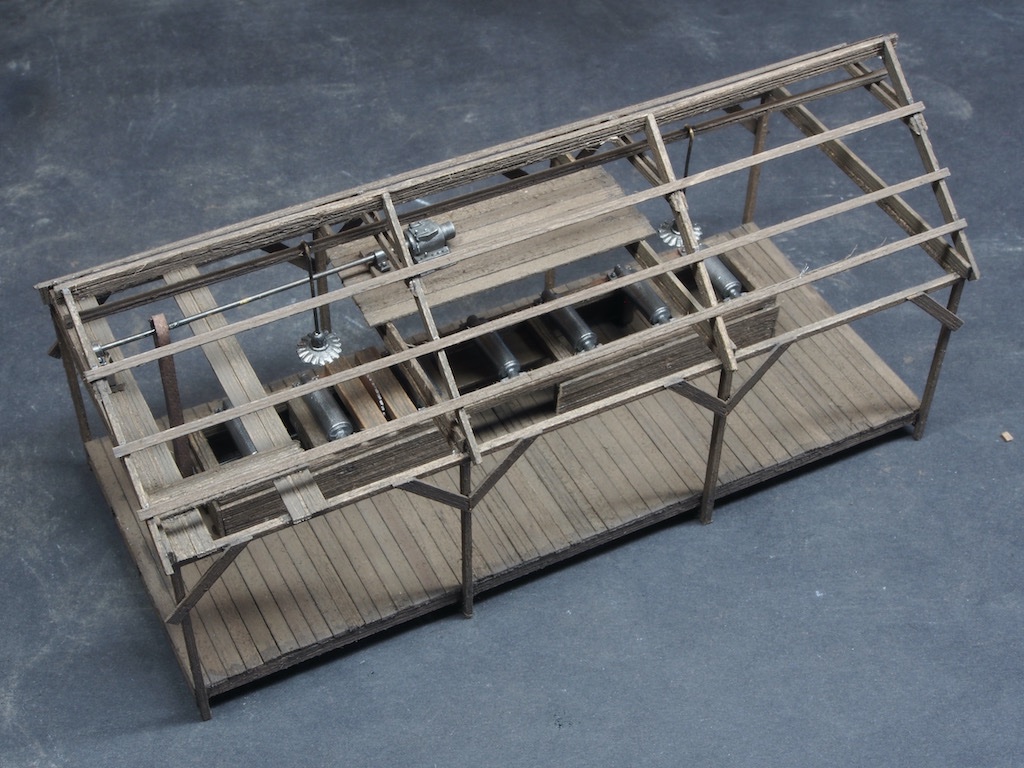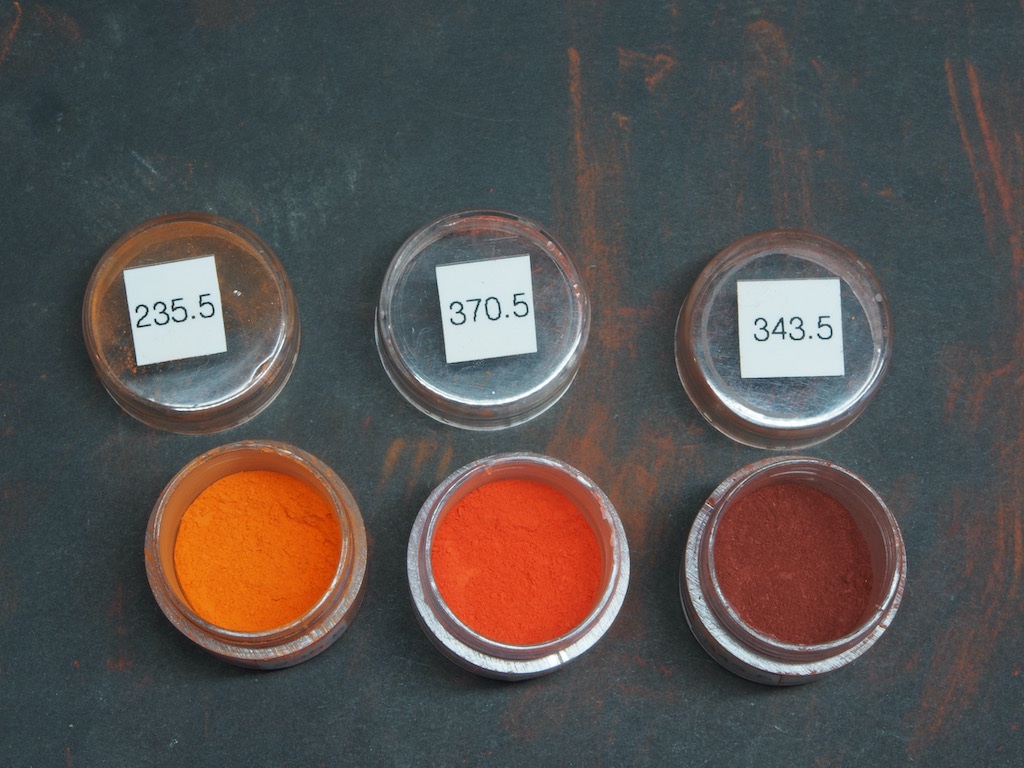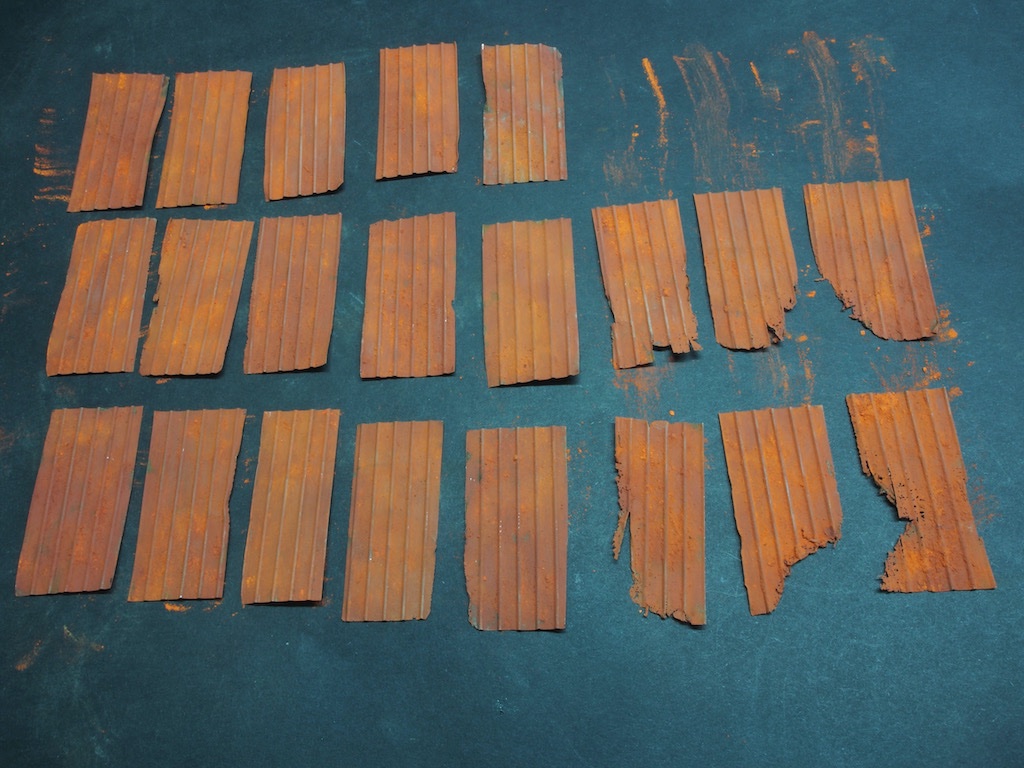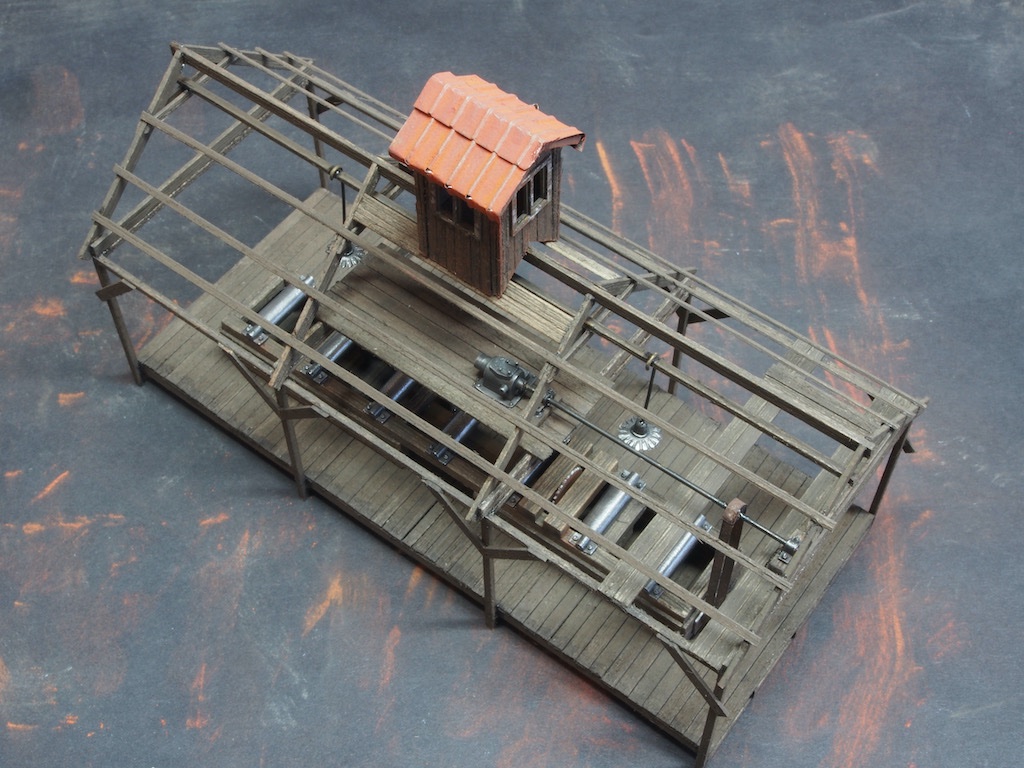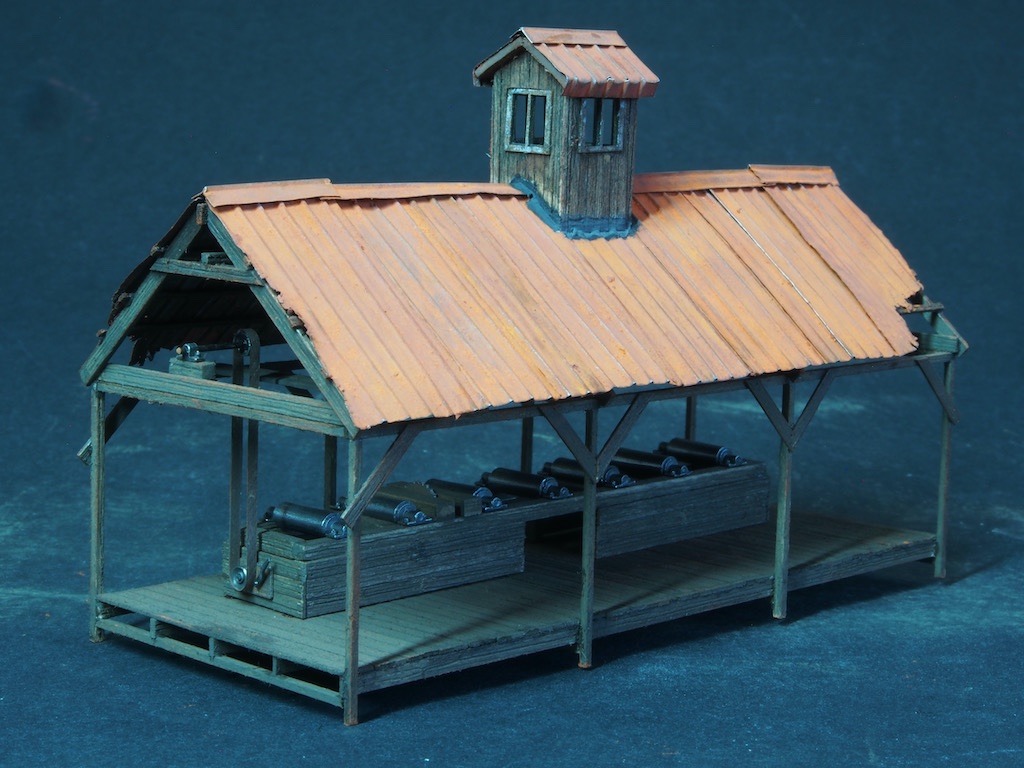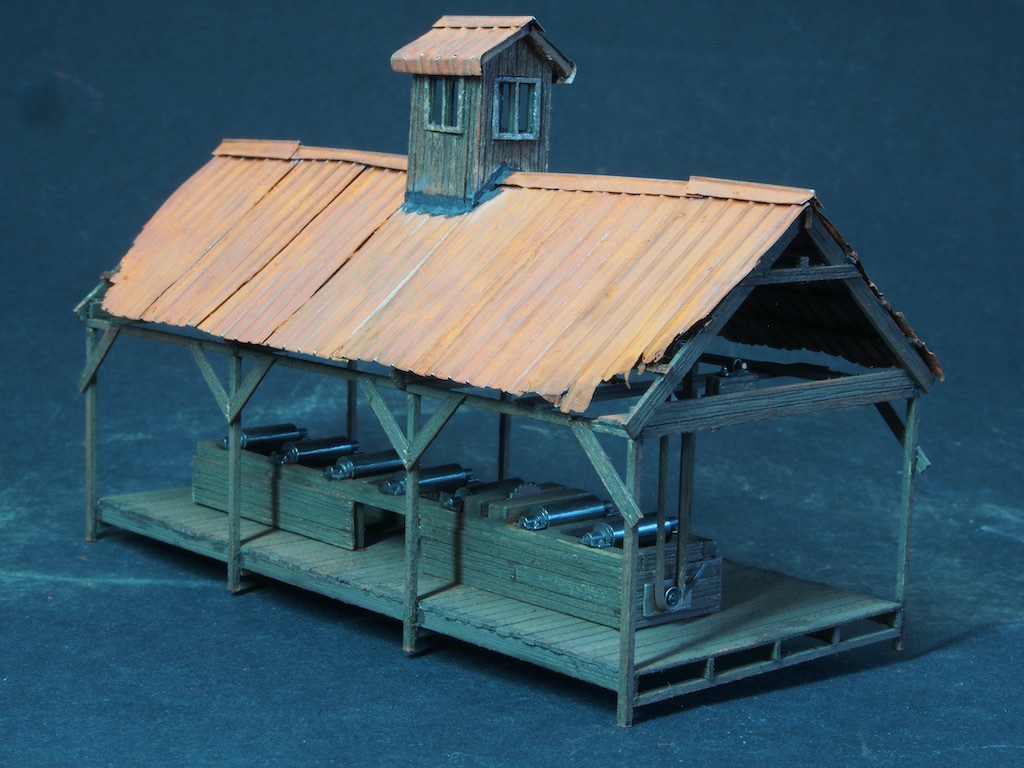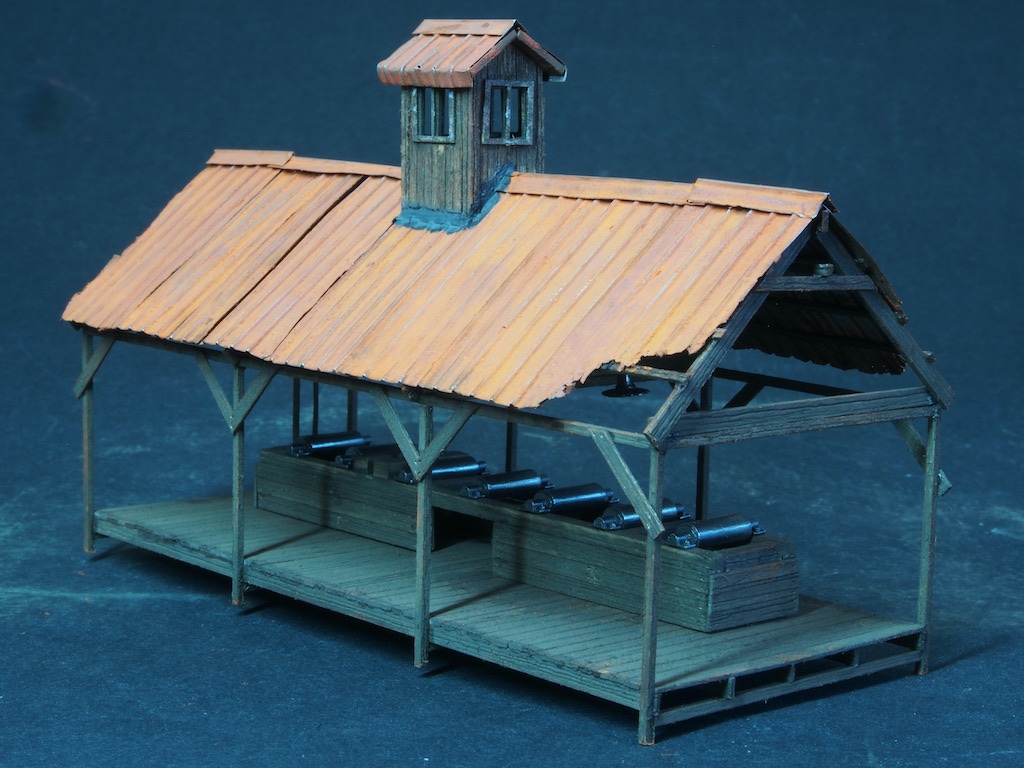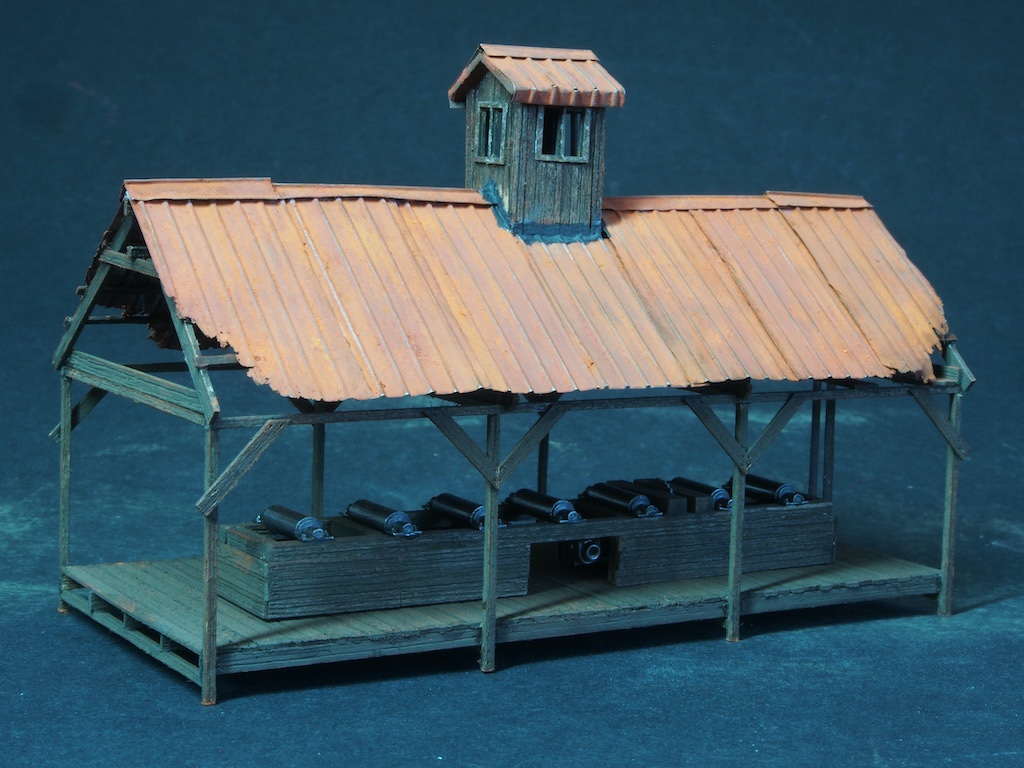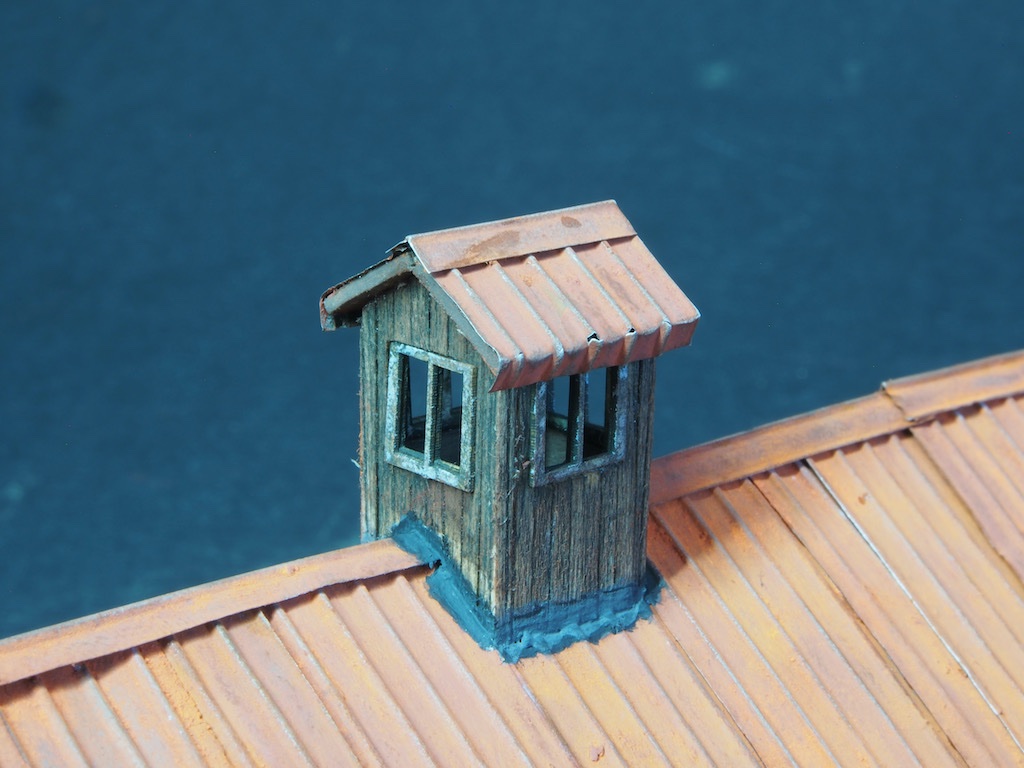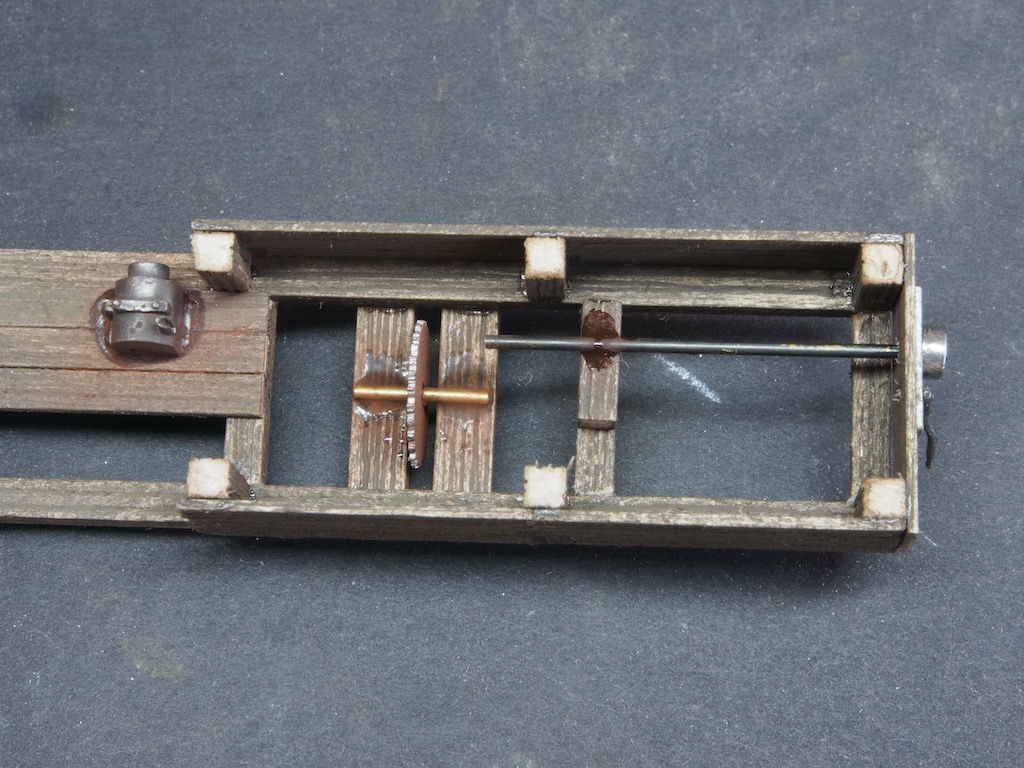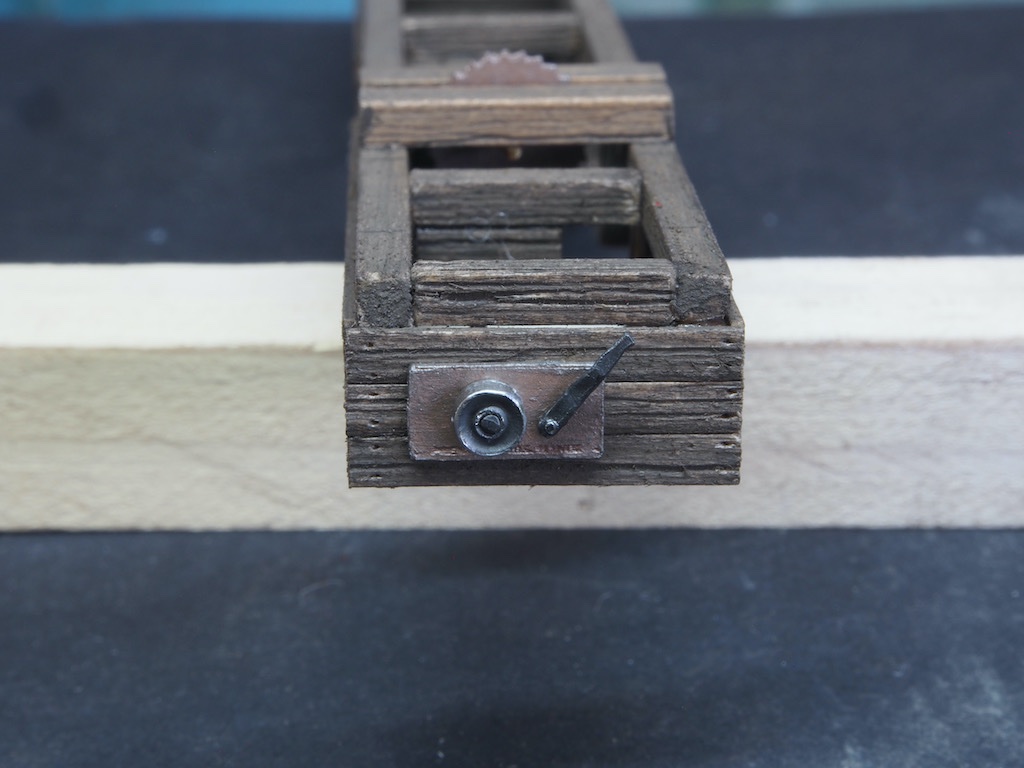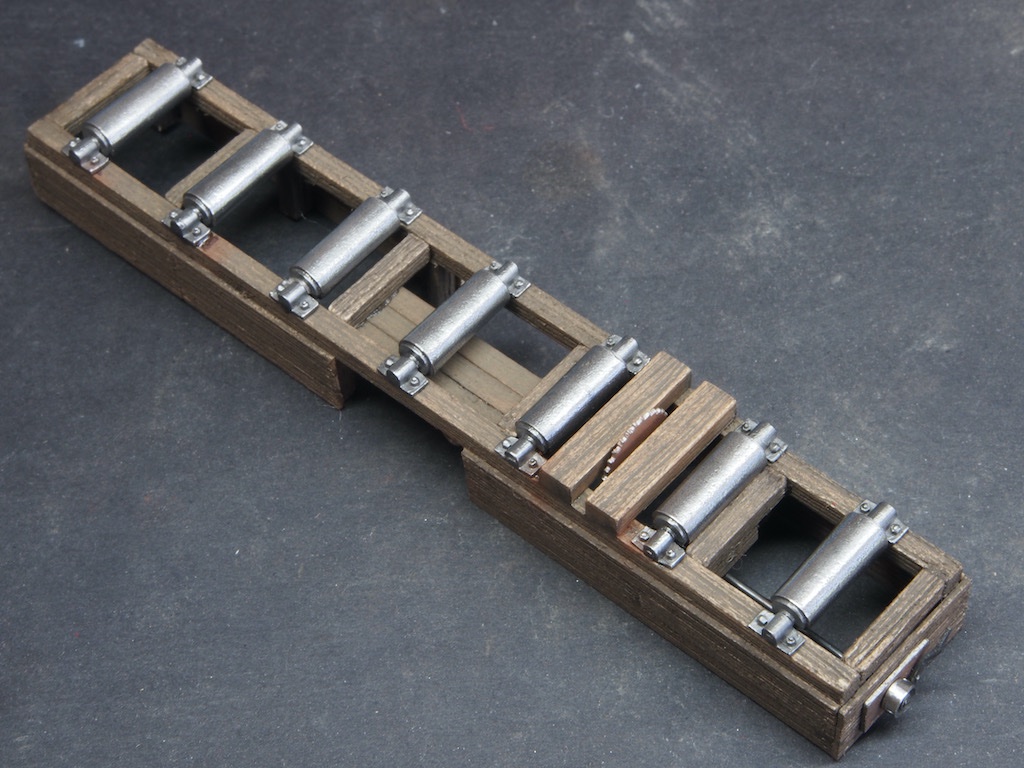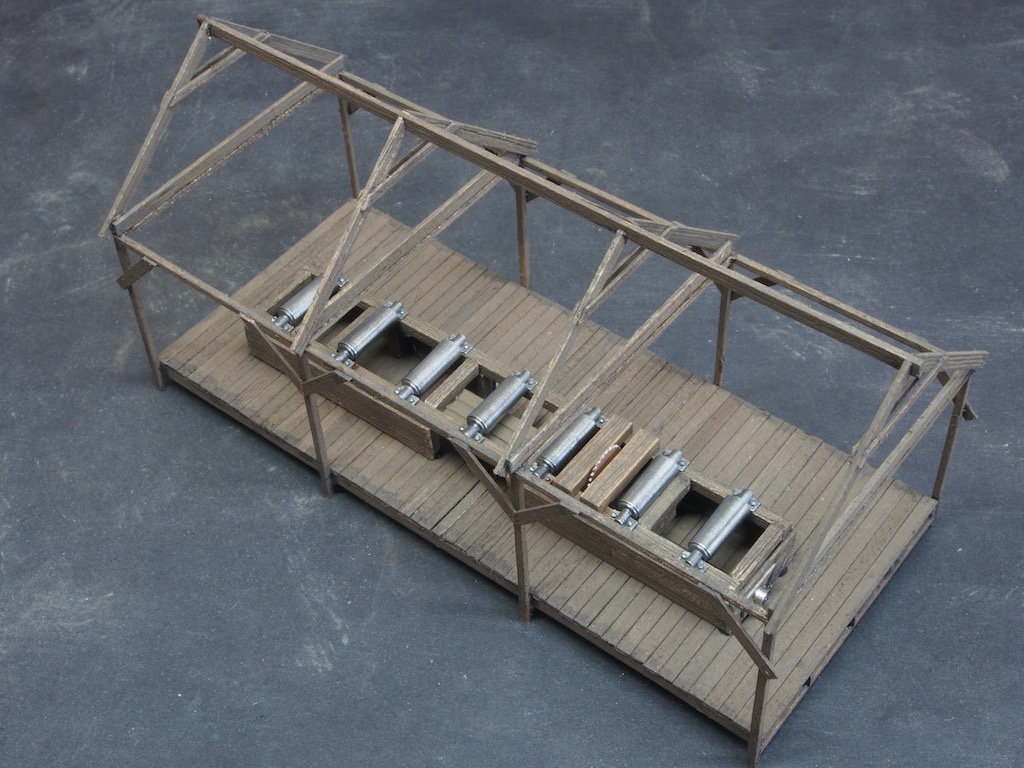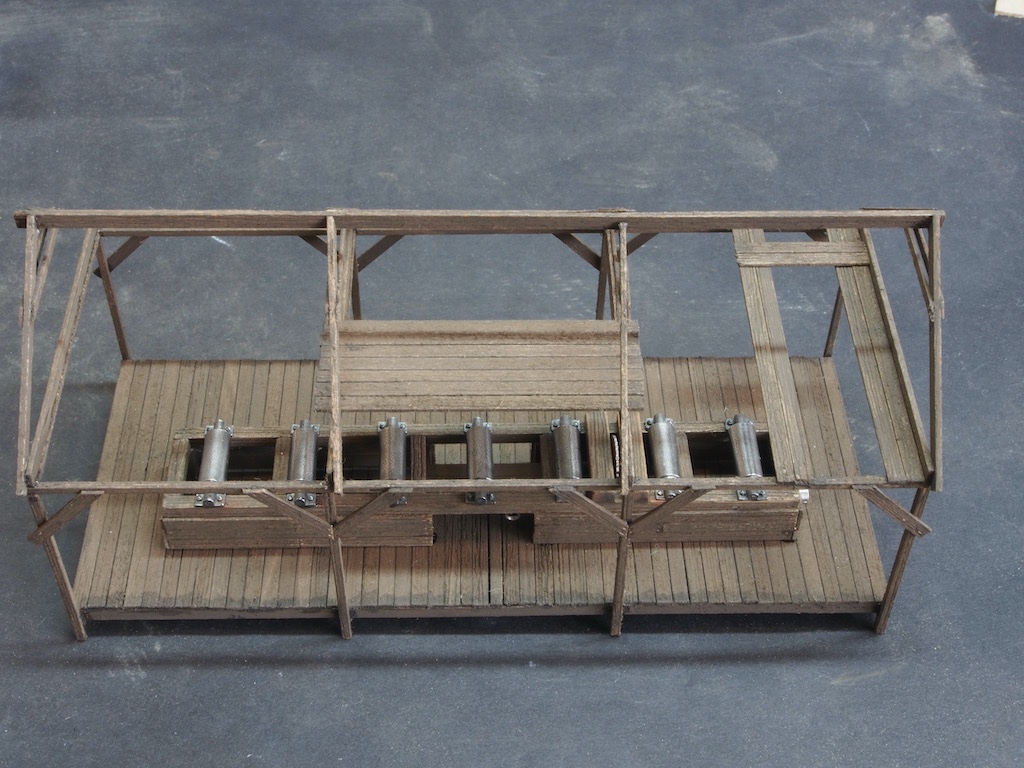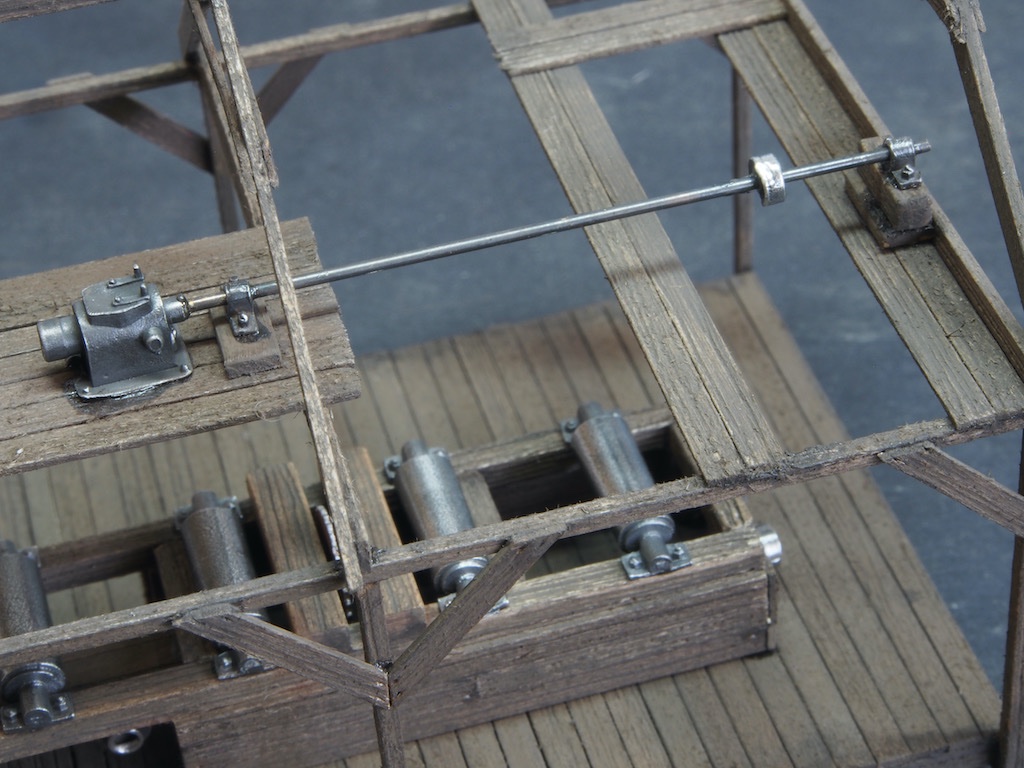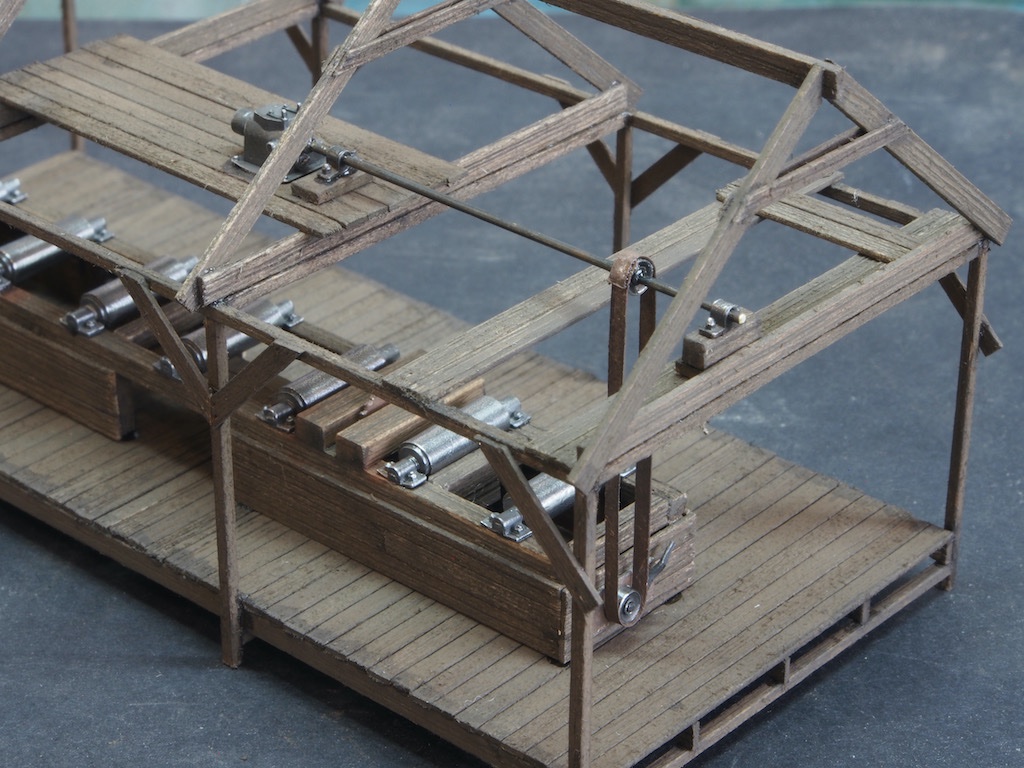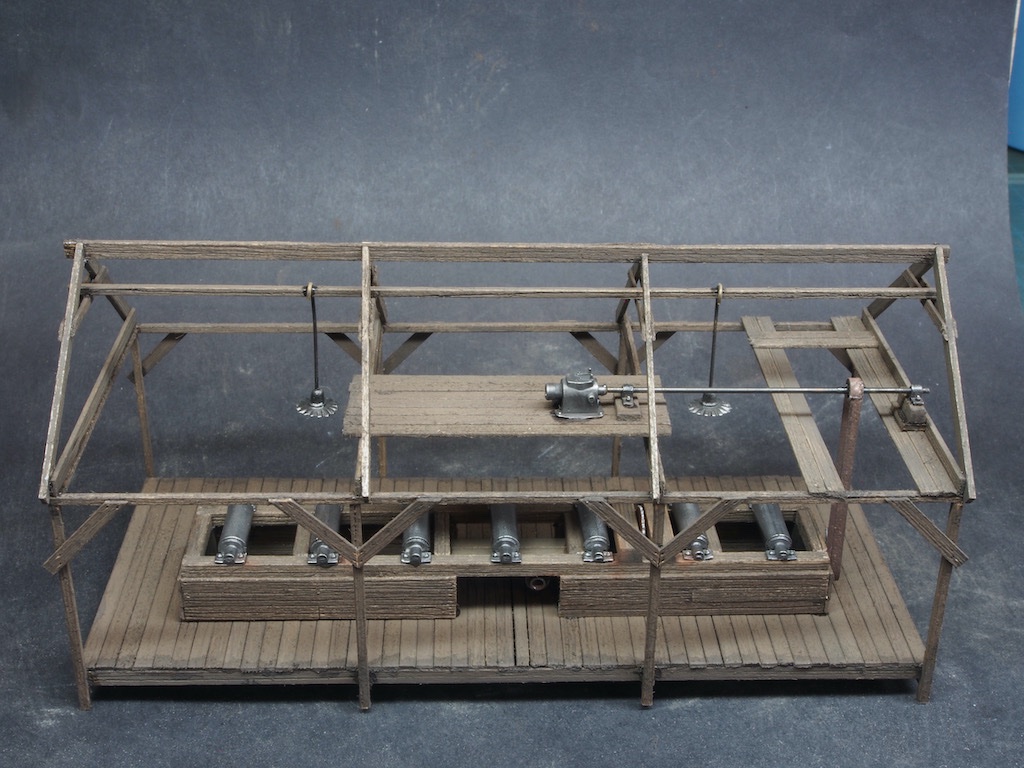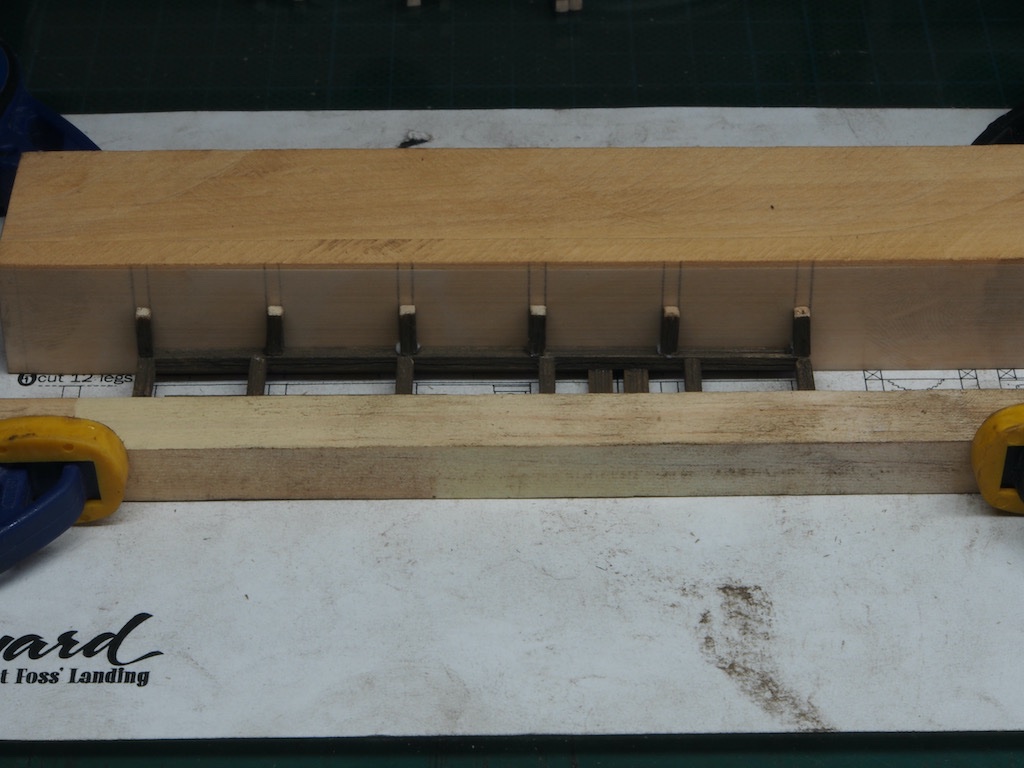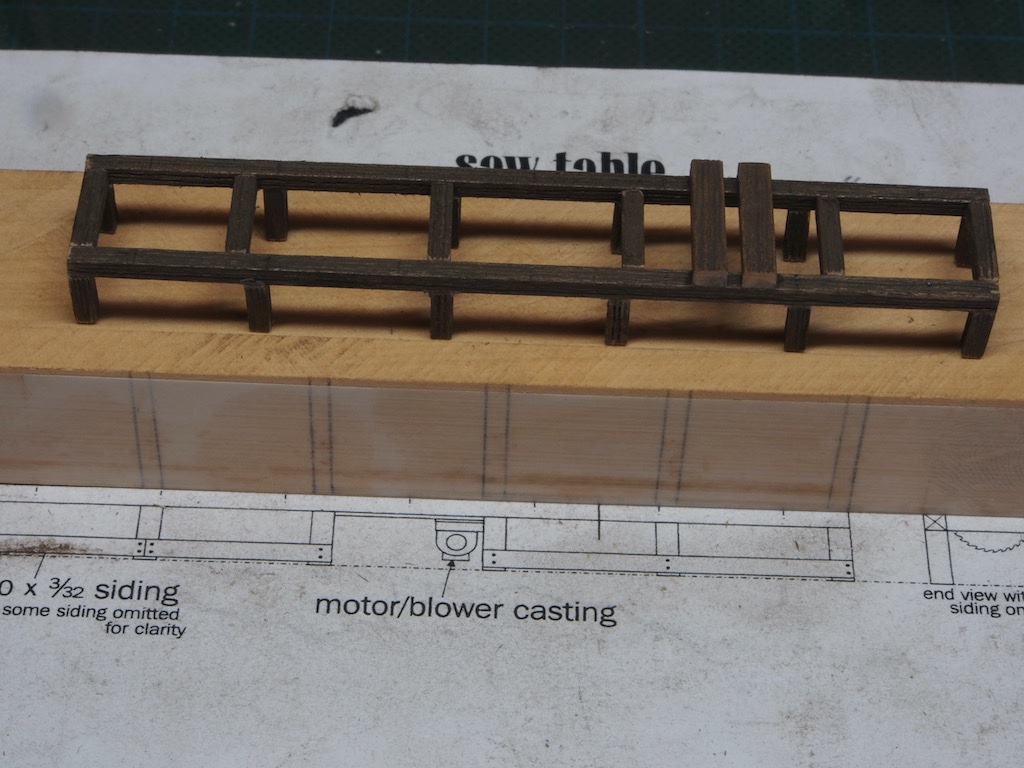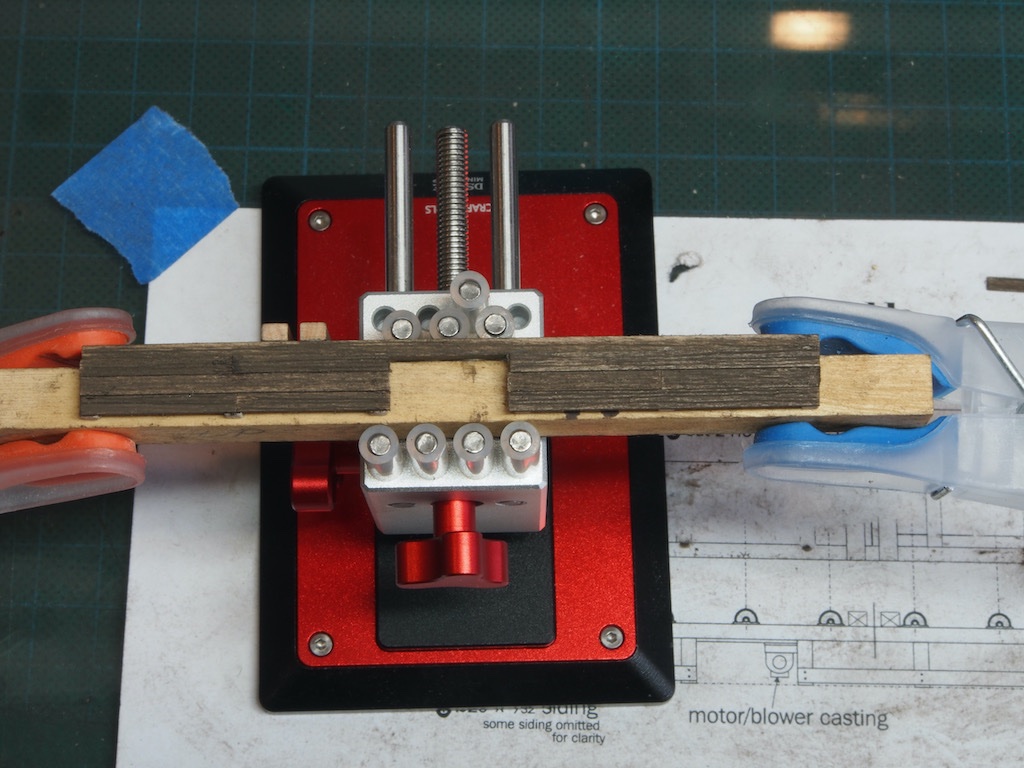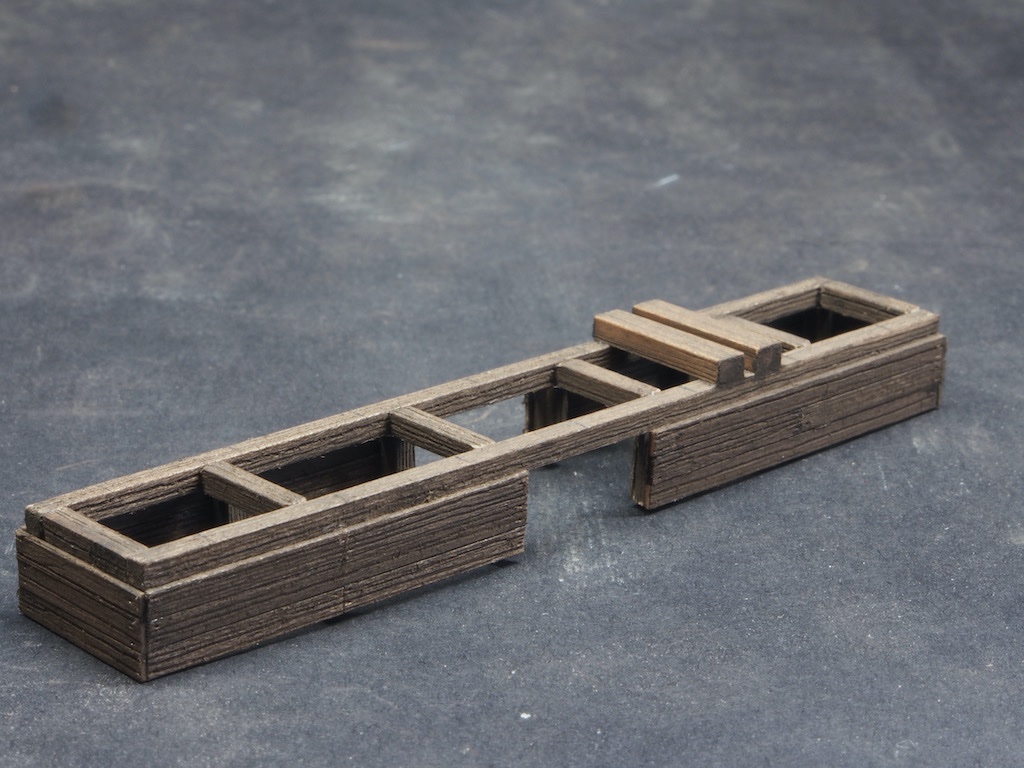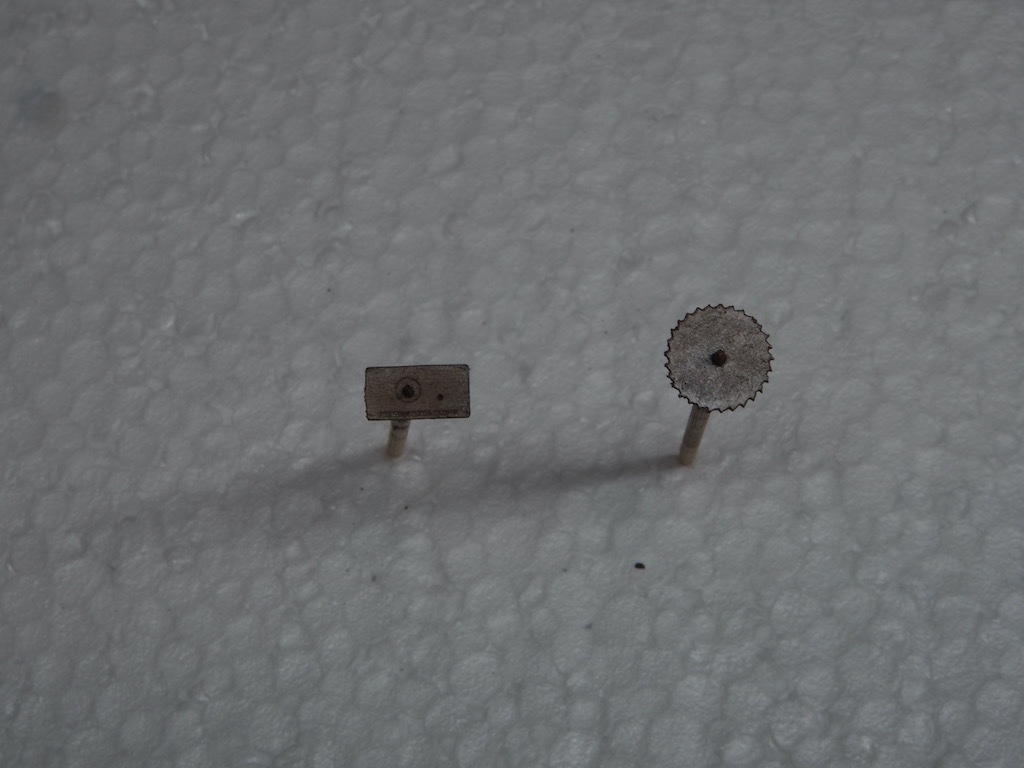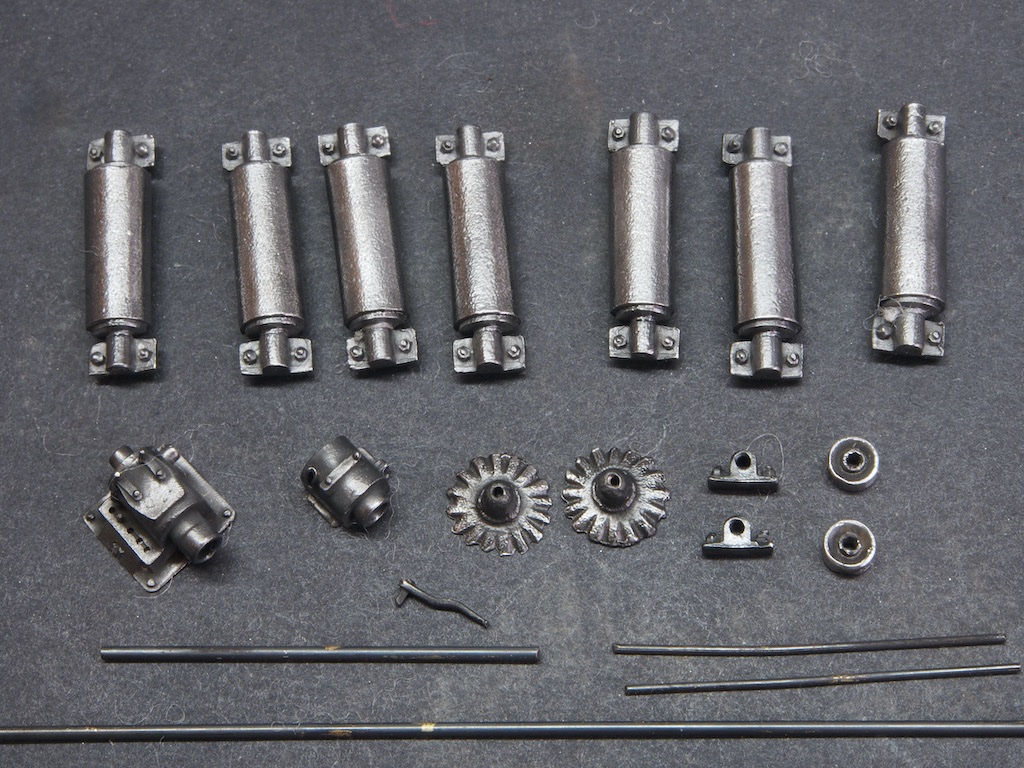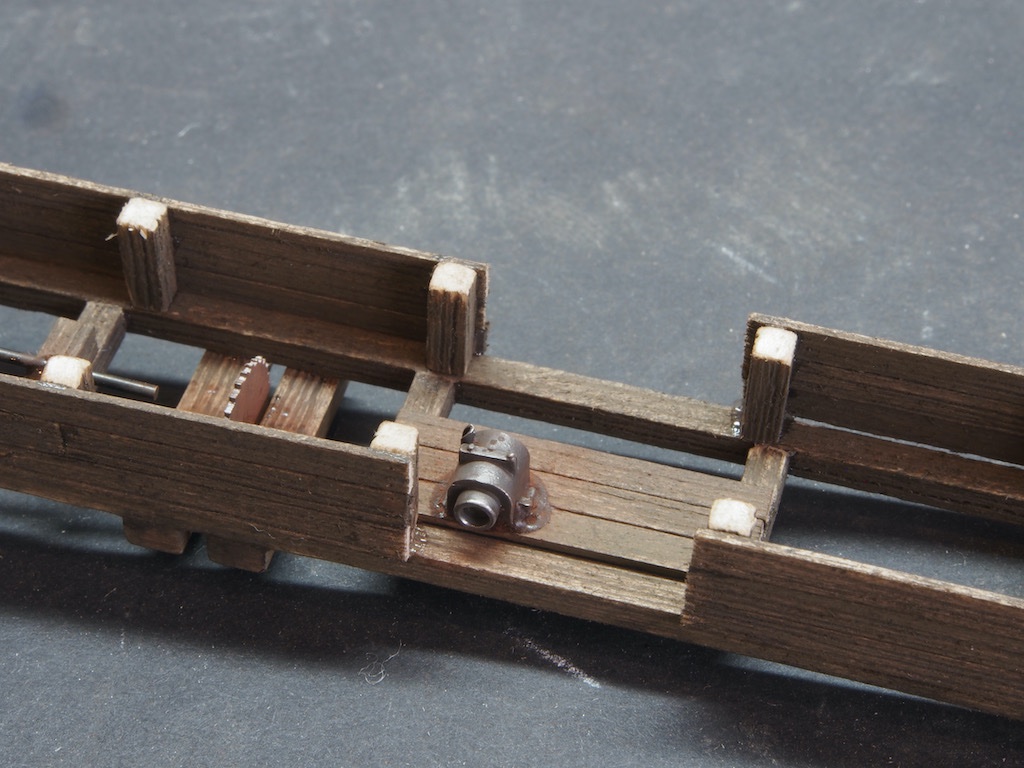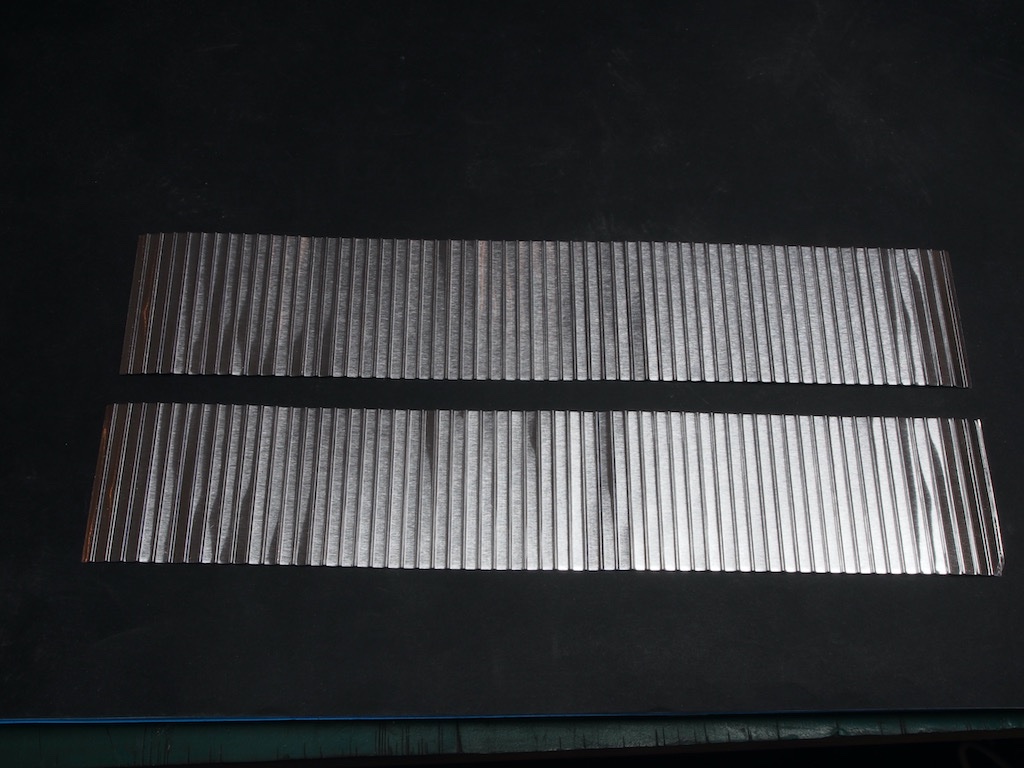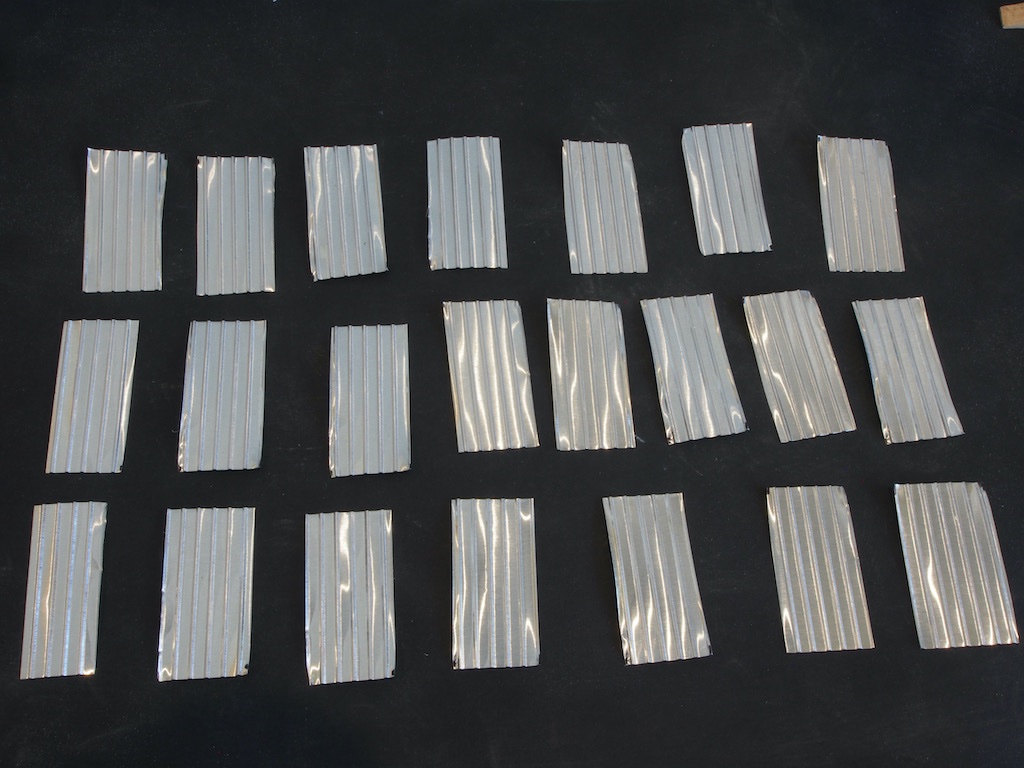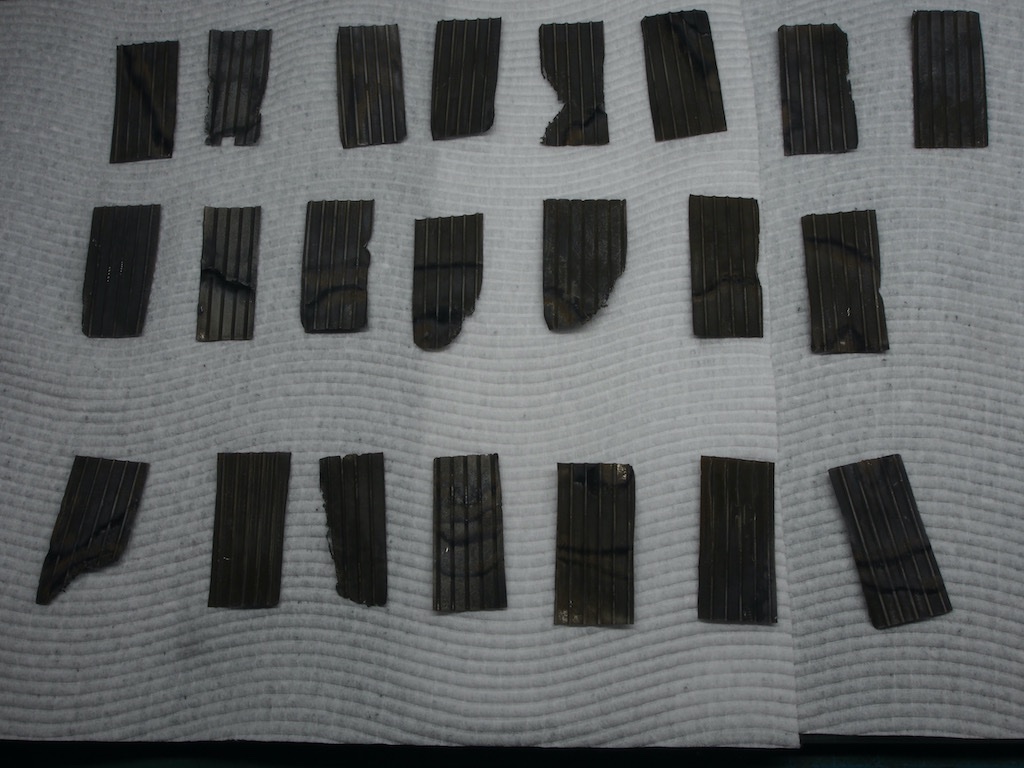-
Posts
4,888 -
Joined
-
Last visited
Content Type
Profiles
Forums
Gallery
Events
Everything posted by gjdale
-
Thanks again everyone for the kind comments and all the likes. It's been an "interesting" week or so.... The Ship Under Construction The ship under construction is an important element in the diorama – after all, it is the reason for the existence of the Shipyard! We begin with the Keel, which is provided in the form of three laser cut pieces – one cardboard central piece, and two outer veneers that include some laser scribing. The outer pieces are first given a light wash with AK 11110 (Leather Brown) – my substitute for Floquil Roof Brown – and then stained with chalk and alcohol. The three pieces are then glued together, and some trim pieces added at stern and stem. The keel supports are now added, building them up as needed to keep the keel relatively level. The frames (or “ribs” as the instruction manual calls them) are made up of a three part lamination in the same way as the keel. Again, the outer pieces are stained prior to gluing up. The central pieces have a laser engraved number on them, but as this disappears once glued up, I took the sensible precaution of numbering the carrier sheet to ensure later positive identification. We then start adding the frames to the keel notches. I had placed four of these when I had the thought that perhaps the ship would look better if the timber looked more like freshly cut wood, rather than the same weathered look of the buildings. While I was thinking on this, I had a PM from one of the people following my build suggesting exactly that and pointing me to a thread where he had done exactly that. So, there was nothing for it but to deconstruct the frames and keel supports and re-visit the colouration, starting with giving all the pieces a light sanding. Following the example given in the discussion thread, the next step was to apply a base coat of AK11004 (Ivory) – my substitute for FLoquil Aged (Antique) White. After a little trial and error, I then settled on a combination of Rembrandt 231.3 (Golden Ochre) and 234.3 (Raw Sienna) chalks. Once the alcohol/chalk treatment had dried, I went over all the pieces lightly with a steel bristle brush. This removed the excess chalk and ensured that any scratch lines followed what would be the line of the grain. Here is the keel ready to go. And here are the frames also ready to go. During the week, my additional shingles arrived in the post (at last), so I was able to go back and complete the roof on the Yard Master’s Office. This included finishing the shingle laying, capping the roof, adding rafters and rafter tails, and adding the flashing at the rear of the roof where it will adjoin the Warehouse. I didn’t take any in-progress shots of these steps as these are simply repeats of earlier work. I was then able to join the Yard Master’s Office to the Warehouse/Main Building. I also decided to switch my photo background from black to white for these shots. After taking these pictures, I realised that the rafters on the end of the Yard Master’s Office are not quite in the right position, so I may have to some delicate deconstruction/reconstruction tomorrow. I also now need to add the roof hardware (chimneys etc), which will be a challenge in its own right!
-
Just a thought Glen, but you could try some "googly eyes" (readily available on Amazon/ebay) - though they might not pass the "too ridiculous" test........
-
I rather thought you might have taken ill with PROVID 22 ( "Procrastination Virus variant 2022") Bob - it happens to all of us. You are quite right about getting going again. Choose something, anything, as long it gets your juices flowing - and start building. I really enjoy following your build logs and miss not having one active to peek over your shoulder with.
-
Nice to see you back at the bench Mark. Your Sphinx is looking great.
- 505 replies
-
- vanguard models
- Sphinx
-
(and 1 more)
Tagged with:
-
Continued from previous post... We are then instructed to complete the preparation of the brick retaining wall and the sea wall, both resin castings. The brick retaining wall comes in two pieces that fit together like a jig-saw puzzle and is designed this way to show the deterioration of the wall. In the picture below, the brick wall has been painted its base colour, while the sea wall (also two pieces) are shown in their unpainted state. The process for the brick wall is to paint the casting, then cover the entire casting in plaster, washing off the surface to leave the plaster in the joints. I had some trouble with this as when I washed the plaster of the surface, it also took the paint off. I had done this using acrylic paint (AK paints). After a second failure, I spent some considerable time cleaning as much of the plaster out of the joints as I could before starting again with a lacquer-based paint. Here are the wall pieces after cleaning out. And after application of a red-oxide lacquer primer and re-treatment with the plaster. The sea wall gets an initial undercoat of AK 11008 (Grimy Grey). A random application of three other colours is then applied AK 11031 (Buff), AK 11007 (Rock Grey) and AK 11057 (Vampiric Flesh). A light wash of alcohol and chalk powders is then applied (I used both 408.3 (Raw Umber) and 411.3 (Burnt Sienna)) for this. These washes produce quite a transformation… The walls are then test fitted and a strip of scrap wood used to block them up to just below the surface of the diorama before epoxying into place. We now leave the diorama base for the time being and commence construction of the star of the show – the ship!
-
Continued from previous post... We are then instructed to test the fit of the ties we will be using, ensuring they fit flush under the rails extending from the dock, and then to epoxy these down. The ties are not included with the kit, presumably because there is an assumption that anyone building this kit is a model railroader and will have their own supply of these. A quick search on the internet and I was able to locate and procure some HO scale ties (Mount Albert brand). I could have made these from scratch material, but this was a quick and convenient solution. The bigger problem was how to space them correctly, and before that, working out what the correct spacing between ties should be. A search on the internet revealed that there are three common spacings between centres used (assumed “standard” gauge and not “narrow” gauge) – 20” for “main” line, 22” for “branch” line, and 24” for “sidings”. Lacking any further guidance, I decided that the lines in this diorama would be considered “sidings”, so went with 24” between centres. I then drew up a paper template using TurboCAD and attached this to simple jig using temporary spray adhesive. The jig is simply a scrap piece of 9mm MDF with another piece of scrap wood as a straight edge to but the ends of the ties against. Two pieces of very narrow double-sided tape are then laid on top of the template to hold the ties in place. And the ties are added – in the example below, the is the longer of the two tracks that will run alongside the derrick dock on the left of the diorama. The ties have all been “grained” and cleaned of fuzz. I initially tried staining them first, but quickly discovered that they would not stick well to the double sided tape, nor the masking tape in the next step. A piece of high tack masking tape was then laid over the ties and pressed firmly into place. The entire template assembly was then removed from the jig by carefully peeling away the template paper from the jig (hence the use of temporary spray adhesive earlier on). The excess tape and template paper were then trimmed from the edge, and the remaining template paper carefully removed along with the double-sided tape, leaving the ties attached only to the masking tape and ready for placement. Having marked the position of the tracks onto the diorama base, a layer of epoxy was applied to the base and the ties placed in position. I used a 15 min epoxy for this task just to allow myself a little extra time to make sure everything was in the right place. Once the epoxy had cured, the masking tape was removed, et voila! The ties were given the alcohol and chalk powder treatment. For these I was going for a much more greyish tint to the colouring than used on the main buildings. Continued next post...
-
It's been a while since the last update, but that doesn't mean that I've been idle. Quite a few pics for this update, so I'll spread them over three posts. The Diorama Base Our attention now turns (temporarily) to the preparation of the diorama base. This starts with a base board of ¾” thick MDF cut to a size of 18” x 17 ½”. The instructions call then for two layers of ½” thick Styrofoam house insulation for a total thickness of 1”. I could only find 30mm thick stuff locally, so went with that instead. This is cut to a basic outline (shown with various measurements in the instruction manual) and glued to the MDF substrate. The instructions suggest using hot glue for this – I went with Elmers Glue-All (looks like a type of PVA) instead and this worked just fine. I couldn’t resist checking out the basic “fit” of the various structures at this stage. As the top surface of the main dock must be level with the top surface of the main building foundation, I made up a measuring stick to determine the height of some temporary pilings for the dock, taking into account the thickness of the dock main supports. A few of these temporary pilings were then spot-glued to the underside of the dock. The foundation epoxied in place, following exact placement dimensions from the instruction manual, and the dock test fitted to check alignment of the top surfaces. Another quick test fit of the main buildings, and all looks good. Some further shaping of the Styrofoam is then called for. This is simply achieved with a sharp snap blade utility knife and includes an initial rough shaping of the “pit” (where the ship under construction will be placed) and a “shelf” to allow the end of the dock to sit flush against the building foundation. I also gave the Styrofoam and base board a coat of paint, using some water-based artist’s acrylics. More to follow....
-
Glad to hear you’ve finished mucking about with the EASY bit Glen. 😉 Looking forward to seeing how you tackle the hard bit.
-
Don’t know about Canada, but we all heard it Downunda too - along with the sound of the Scotch bottle being opened….
-

EURYALUS 1803 by Peter6172 - 1:48
gjdale replied to Peter6172's topic in - Build logs for subjects built 1801 - 1850
Nice work so far Peter. -
Thanks again for all the kind comments and likes folks. The Saw Shed (Continued) Back to the roofing. We start by constructing the cupola. This is done in exactly the same way as the cupola for the main roof, with carboard substrate/template, prepared timber siding, and the addition of windows with a peeling paint effect. Here are the four sides ready to be glued up. Next, some purlins are added to the roof to support the roofing sheets. The roofing sheets received some preliminary preparation with ferric chloride in an earlier post. It was now time to “rust” them up. The instructions were a little vague on this point, “apply some rusty coloured chalk powder”. Perhaps there is an assumption that by this stage we are capable of making our own decisions about how to apply this. Fair enough. I chose three colours to create my version of rust: Rembrandt 235.5 (Orange), 370.5 (Permanent Light Red), and 343.5 (Caput Mortem Red). My method was as follows: - tip a generous pile of each of the three colours, well separated from each other, onto my glass work plate - dip a brush into isopropyl alcohol then remove most of the alcohol on a paper towel - dip the tip of the brush into the darker colour (343.5) and “blot” onto the roofing sheet. - while the sheet is still damp, using a DRY brush, blot generous amounts of both the other colours, then shake/tap/lightly brush off the excess. I’ve no idea whether this method is considered “correct”, but it seemed to work for me. Here are the sheets ready for installation. The cupola receives its roof first. After installing a couple of support boards between the rafters, the cupola is then fitted. After this picture was taken, I realised I’d done the ridge capping incorrectly and re-did this. I then proceeded to attach the roofing sheets to the roof. Again, the instructions were a little scant on this, inviting us to simply glue them on. I wasn’t sure what sort of glue to use for this. As I had successfully used PVA to attach the little cupola roof, that’s what I went with. Big mistake. I had all sorts of problems trying to hold pieces in place while the glue set up but pushed ahead regardless. When I finally got all the main pieces on, I went to install the ridge capping and found that PVA just wasn’t going to cut it. So, I went with epoxy for these pieces. Then I went to take some photos to upload to the build log and that’s when the camera made it very obvious that this roofing job was just not up to par. I though on this overnight and decided that a re-work was in order. A day spent on a re-do is nothing compared to forever looking at a botched job! The main issue was how to deconstruct the roofing without destroying the rest of the building. As I’d used epoxy on the ridge capping, I needed to use acetone to de-bond those pieces. That went quite quickly, and they came off without too much trouble at all. To de-bond the main roofing sheets, I used isopropyl alcohol, being as careful as I could not to inadvertently de-bond any major structural components. In the end, it was only the purlins that came away with the roofing sheets. Oh, and the cupola kinda fell apart too. The only real downside was that although I’d successfully removed the roof sheeting, the process also took off most of the rust colouring, so I had to re-do that (using the same process described earlier). Unfortunately, I didn’t take any photos during the deconstruction phase. Having re-built the cupola and re-coloured all my roofing sheets, I decided to try a different approach to gluing and broke out the CA gel. I don’t normally like to use CA glue in any form as I have a sensitivity to it and develop flu-like symptoms at the slightest exposure. But, there was not readily apparent alternative, so I put on my big boy pants and got on with it. This time the whole process went quickly and easily and before I knew it, I had the roof back on. The final job was to put some “flashing” around the base of the cupola. The instructions say to use epoxy coloured with some paint as we’ve used earlier on, but I find this a little messy to apply. So, taking a tip from another build log, I decided to use some PVA coloured with a little paint and applied using a syringe. That seemed to work quite well and once dry I “painted” some black and grey chalk powder with a little alcohol to dull down the shine and leave a nice dark grey flashing. Here are some pictures of the completed shed. The next task will be to start work on the diorama base – another “totally new to me” excursion…
-
Looking good Glen, and a cunning plan for insertion. After your last couple though, this one should be a walk in the park!
-
Continued from previous post... The saw blade receives a small brass rod “axle” and is then epoxied in place. At the same time, the end plate is glued in place and another shaft inserted through it. It is supported on a block on the underside of the table and as a drive wheel attached at the outer end. The end plate also receives a Feed Handle. This part is truly tiny. I dropped it on the carpet twice and was lucky to find it again both times! Returning to the top of the table, the rollers are now epoxied in place. With the Saw Table now complete, it is permanently attached to the floor of the shed – positioning is indicated on the template. Next, we add some decking to the attic space to support the electric motor and drive shaft. The electric motor is installed, along with the drive shaft, two pillow blocks mounted on scrap timber supports, and the driven wheel. Some special material is provided for the drive belt. All that is required is to cut a 1/16” wide strip, paint it and attach it to the two drive wheels. Two lamps are hung from a support beam to complete the internals of the Saw Shed. Next up we return to the roofing…
-
There are a lot of pictures for this update, so I'll spread this across two posts... The Saw Shed (Continued) We now turn our attention to the Saw Table. Once again, it is built directly onto the provided template. I have to admit, I was not happy with my first attempt at this and scrapped that before starting again. Here is the commencement of the process – the Table Top glued up. To help keep the legs aligned, I transferred their positions onto a large piece of scrap wood and using a second piece of scrap, clamped the tabletop between the two before attaching the legs on the first side. The table was flipped and the second set of legs attached. Here is the end result – much happier with this version. Sides were then added. To provide some support to the somewhat fragile assembly, I clamped it in a small vise with a piece of scrap of a convenient size for support. Here it is with all of the sides attached. The saw blade and an end plate are provided as laser cut pieces. These were painted with AK 11210 (Natural Steel) and then dirtied up with a bit of dark rust coloured chalk powder. In the picture below, they are each held on the end of a toothpick – just to give an indication of size! The next task was to clean, blacken and buff all of the metal castings and brass rod required for the rest of the saw table and shed. Some additional planking is added to the underside of the table and the blower unit epoxied in place. Continued next post...
-

EURYALUS 1803 by Peter6172 - 1:48
gjdale replied to Peter6172's topic in - Build logs for subjects built 1801 - 1850
Peter - just a thought on the use of the sticky label paper. If you cover your timber with painter's masking tape first, it will be much easier to remove the labels after cutting out - and no sticky residue to clean up. -
The Saw Shed (Continued) A minor update today. The Saw Shed Ridge Beam has now been installed. Our attention turns, temporarily, to the shed roofing. The Saw Shed is roofed with corrugated iron sheeting. The kit provides some corrugated aluminium siding and some instructions on how to prepare this. Here is the raw kit material – two strips about 8 inches long by 1 ½” tall. The first task is to cut this into strips about ¾” wide. Now the fun part…. To achieve an aged and rusted look, the aluminium is treated with Ferric Chloride PCB etchant solution. Yes, nasty stuff, but quite safe if proper precautions are taken – and the instruction manual is quite emphatic about this! The method is to dunk a piece of aluminium into the Ferric Chloride solution with a pair of long tweezers. The instructions say that after a few seconds the piece will start to bubble. I found that it took a good couple of minutes for any reaction to start, but once it started it was very quick! Once it does start to bubble, it is removed from the solution and dunked in clean water to stop the chemical reaction. The longer it is left to bubble, the more of the aluminium gets eaten away. I experimented a little bit to produce some with heavily frayed edges. I will use these judiciously to represent some more rusted/worn panels. Here are the pieces after the “mad chemist” treatment. These will eventually have rust coloured chalk applied before being installed, but for now they are put aside. The next task will be creating the Saw Table – a mini-project in itself….
About us
Modelshipworld - Advancing Ship Modeling through Research
SSL Secured
Your security is important for us so this Website is SSL-Secured
NRG Mailing Address
Nautical Research Guild
237 South Lincoln Street
Westmont IL, 60559-1917
Model Ship World ® and the MSW logo are Registered Trademarks, and belong to the Nautical Research Guild (United States Patent and Trademark Office: No. 6,929,264 & No. 6,929,274, registered Dec. 20, 2022)
Helpful Links
About the NRG
If you enjoy building ship models that are historically accurate as well as beautiful, then The Nautical Research Guild (NRG) is just right for you.
The Guild is a non-profit educational organization whose mission is to “Advance Ship Modeling Through Research”. We provide support to our members in their efforts to raise the quality of their model ships.
The Nautical Research Guild has published our world-renowned quarterly magazine, The Nautical Research Journal, since 1955. The pages of the Journal are full of articles by accomplished ship modelers who show you how they create those exquisite details on their models, and by maritime historians who show you the correct details to build. The Journal is available in both print and digital editions. Go to the NRG web site (www.thenrg.org) to download a complimentary digital copy of the Journal. The NRG also publishes plan sets, books and compilations of back issues of the Journal and the former Ships in Scale and Model Ship Builder magazines.



